The 25th anniversary of the fall of the Berlin Wall
Saturday and Sunday, November 8 & 9, 2014
Part 2
Speech by Federal Chancellor Angela Merkel at the 6th Falling Walls Conference
Date Nov 08, 2014
Location: Berlin
Professor Turner,
Professor Mlynek,
Professor Eissenhauer,
Excellencies,
Ladies and gentlemen,
Thinking over, rethinking, thinking ahead – that’s what you’ve come here to do. The monumental installation by David Chipperfield, to whom I’d like to extend a very warm welcome, is a source of inspiration for this. I welcome all of you to Berlin, this city which has written history.
The Falling Walls Conference brings together the past and the future in a very special way. It combines the commemoration of the fall of the Berlin Wall 25 years ago with a look ahead at which frontiers can be overcome today and tomorrow. It combines experiences and the hope of a good, indeed a better, life in future – a hope fuelled in particular by science and research. The Falling Walls Conference thus focuses attention on a key prerequisite and driving force of human action. This was, is and will remain freedom.
Tomorrow we will be celebrating the 25th anniversary of the fall of the Berlin Wall. This day brings home to us that the human urge for freedom cannot be suppressed forever. In the course of that fateful year, 1989, more and more East Germans overcame their fear of state repression and harassment. They exposed the fraud at the local elections. They gathered in churches to discuss openly. They founded civil rights movements and took to the streets to voice their demands.
On 7 October 1989, the SED grandees celebrated the 40th anniversary of the GDR with the customary pomp. At the same time, they ordered the security forces to harass people who were demonstrating peacefully. Despite this, just two days later tens of thousands of people gathered in Leipzig for the Monday demonstration. A line had thus been crossed. There was no going back. More and more people showed civic courage. It’s thanks to their courage that the barriers at the border between the two German states were finally opened.
In contrast to 1953 in East Germany, 1956 in Hungary, 1968 in Czechoslovakia or 1981 in Poland, the longing for freedom and self-determination could no longer be crushed; neither in East Germany nor anywhere else. The human need to be able to take one’s destiny into one’s own hands turned the cruel division of Europe and the Cold War into a thing of the past. Today around 500 million people from 28 member countries live within the European Union. They live together in peace and freedom. Others would like to become part of our community. Our coming together under one roof is the forward-looking answer to the antagonism of former days.
The lack of communication, the boundless distrust and cold confidence in military logic which prevailed one hundred years ago when the First World War broke out have become inconceivable. We are also remembering this event in 2014, as well as the outbreak of the Second World War 75 years ago. Both wars left many millions dead – both soldiers and civilians. They reduced our continent to rubble. They left a trail of unspeakable horror. We Germans will never forget that it was our country which broke all the rules of humanity during the National Socialist era. Due to the Shoah, that ultimate betrayal of all civilised values, Germany has an ever-lasting responsibility.
After all these horrors, Europe was not yet able to come together. The Cold War followed. Germany, Europe and the world were divided into two blocs. The wall which cut Berlin in two symbolised this.
25 years ago, in the days leading up to 9 November 1989, the growing protest movement may have led some to think it was vaguely possible that the Wall could fall. However, virtually no one could have imagined that it would only be a matter of hours. It is certainly possible to see a parallel to science in this. In this field, too, some things emerge with ill-defined outlines. But when precisely the breakthrough will happen and – above all – what it will look like exactly and what new possibilities it will offer, sometimes becomes apparent quite unexpectedly.
Freedom is a vital prerequisite and engine for this. Freedom opens up new worlds. Anyone who can think and research freely can better understand the bigger picture, can recognize new paths and is free to embark upon them. Or as the French author André Gide said, “One doesn’t discover new lands without consenting to lose sight of the shore for a very long time.” Yes, it requires courage to gain freedom. And it also requires courage to take advantage of freedom. The Falling Walls Conference wants to give us courage, the courage to overcome the walls around current thinking, to cut lanes and open up new perspectives.
This year’s Nobel Prize Winner for Chemistry gave us a wonderful example which shows that what is seemingly insurmountable can be overcome after all. I would like to take this opportunity to congratulate Professor Stefan Hell most warmly on his great success. His research focuses on nanobiophotonics. Thanks to his pioneering work, detailed resolutions which used to be considered impossible are now possible in the field of microscopy. Basically, he made visible what had previously been invisible. And this has quite literally opened up new and in-depth insights into living cells. This helps to better understand the causes of diseases and, ultimately, to devise targeted treatments.
Health research in particular illustrates very clearly how the pace of scientific advance can affect the standard of living. That’s also the reason why great hopes are often placed in science. To ensure that many of these hopes can be fulfilled, we have made the promotion of science a political focus – in the health field as well as in many other spheres.
We have devoted greater attention in health care to previously neglected diseases caused by poverty. For especially in the field of health research, developed countries like Germany with a strong research record have an international responsibility. That’s why we made this topic one of the focuses of our G7 Presidency.
When I say that, I’m also thinking of ebola, which has hit many parts of West Africa. German scientists are helping to find ways and means of halting the spread of this disease. However, we have to admit that we could probably already have a vaccine if we’d paid enough attention to this disease before the epidemic took hold.
Ladies and gentlemen, there is much I could tell you about what the Federal Government is doing in cooperation with the Länder to steadily advance science. However, rather than go into details, I would just like to say that we are always guided by the idea that only by breaking new ground, only if we are prepared to leave well-trodden paths and encourage people to do this, will we be able to maintain and increase our prosperity.
Ladies and gentlemen, the Falling Walls Conference undoubtedly also offers an excellent opportunity to showcase Germany’s scientific sector. I make no secret of the fact that we’d be delighted if even more top researchers from abroad were to come to Germany to research. Our universities and non-university research institutions have much to offer. We won’t content ourselves with cultivating our reputation as a country which traditionally produces poets and thinkers. Although we’re meeting in a museum today, our intention is not to merely look back. We want to gain a reputation as a country of pioneering thinkers.
For we know that innovation made in Germany as an outstanding seal of quality would be inconceivable without freedom. This also applies to vocational training. In the former GDR, for example, many were not allowed to study even though they were talented. A free state, on the other hand, fosters individual interests and abilities.
We welcome lateral thinkers, people who pursue new avenues. Everyone should have an opportunity, and everyone should take advantage of this opportunity. That’s what makes a country humane. And that’s what makes a country enduringly successful. That will remain the aim and yardstick of forward-looking, forward-thinking policies. In addition, there is a host of initiatives in which people who want to explore new paths, who want to overcome barriers, can come together. The Falling Walls Conference is one of these.
I wish you not only a lovely evening but also fruitful discussions tomorrow. Once again, I bid a very warm welcome to each and everyone of you.
Please visit The Federal Government’s link for more information:
The followings are the articles and photographs from different media:
The Huffington Post on November 12, 2014
It’s Been 25 Years Since The Fall Of The Berlin Wall. These 16 Photos Tell The Story.
The Huffington Post | By Eline Gordts
Posted: 11/09/2014 10:06 am EST Updated: 11/09/2014 10:59 am EST
November 9 marks the 25th anniversary of the fall of the Berlin Wall, the Cold War barrier that divided East and West Berlin for nearly three decades.
Responding to a question by an Italian journalist at a press conference on Nov. 9, 1989, Guenter Schabowski, the spokesman for East Germany’s Central Committee, announced that East German citizens would be able to travel to the western part of the city. The unintentional comment caused thousands of East Germans to rush to the barricade, demanding to be allowed to cross.
Take a look at the incredible photos below from Nov. 9 and the turbulent days that followed.
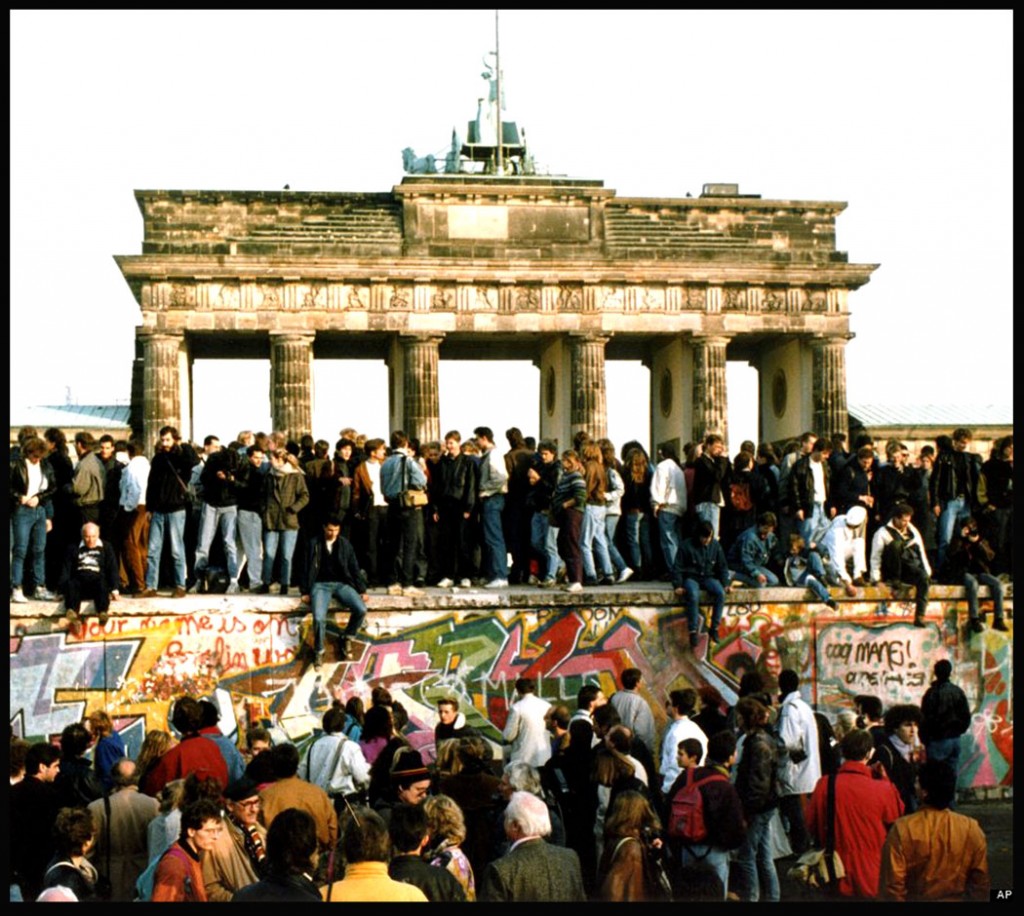 People climb on the Berlin wall on Nov. 10, 1989. (AP Photo)
People climb on the Berlin wall on Nov. 10, 1989. (AP Photo)
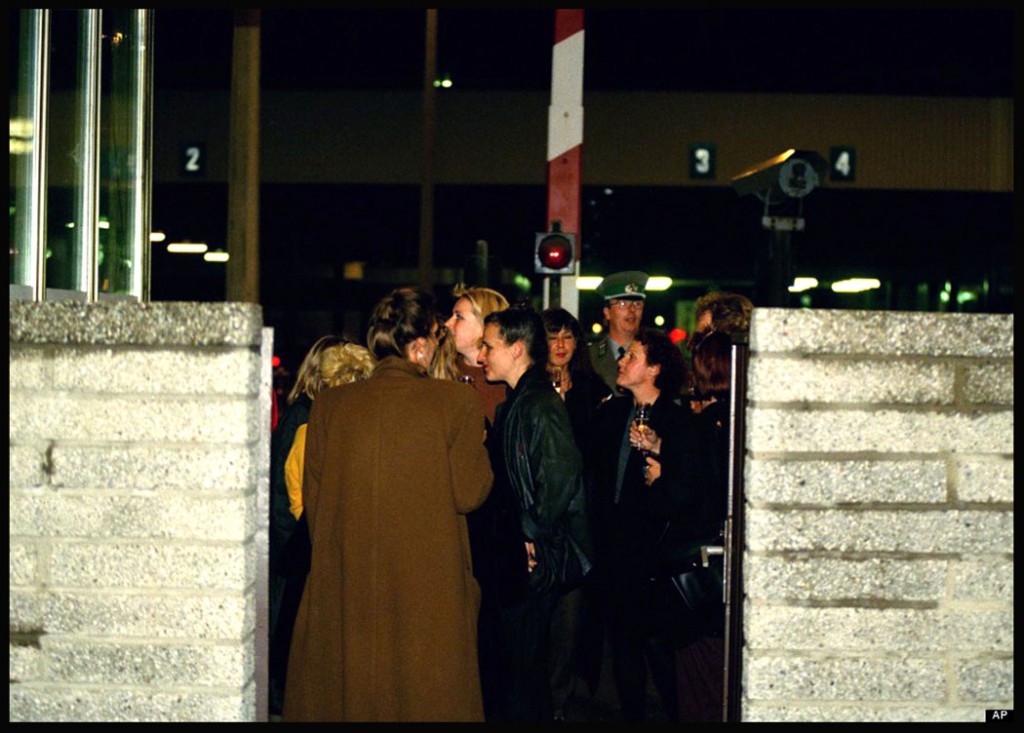 West Berlin citizens celebrate in the eastern part of the Checkpoint Charlie border crossing in West Berlin, Nov. 9, 1989, after the announcement by communist East Germany that it would open its borders to the west. (AP Photo/Lutz Schmidt)
West Berlin citizens celebrate in the eastern part of the Checkpoint Charlie border crossing in West Berlin, Nov. 9, 1989, after the announcement by communist East Germany that it would open its borders to the west. (AP Photo/Lutz Schmidt)
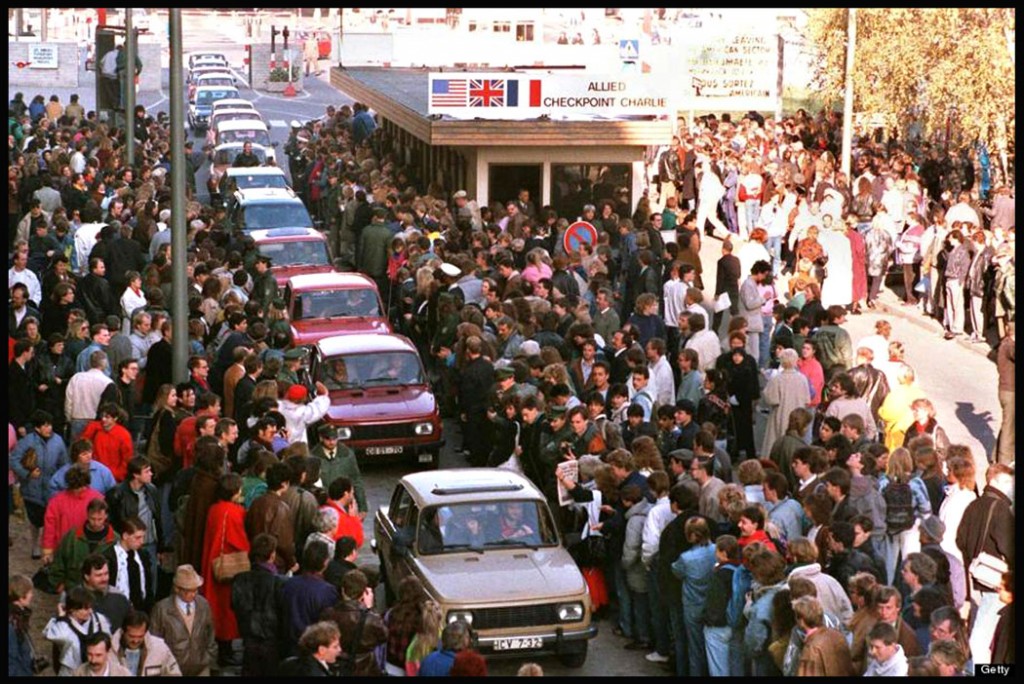 A long row of East German Trabant cars passing through Checkpoint Charlie into West Berlin is greeted by enthusiastic West Berliners, 10th November 1989. (Photo by EPA PHOTOS DPA FILES/AFP/Getty Images)
A long row of East German Trabant cars passing through Checkpoint Charlie into West Berlin is greeted by enthusiastic West Berliners, 10th November 1989. (Photo by EPA PHOTOS DPA FILES/AFP/Getty Images)
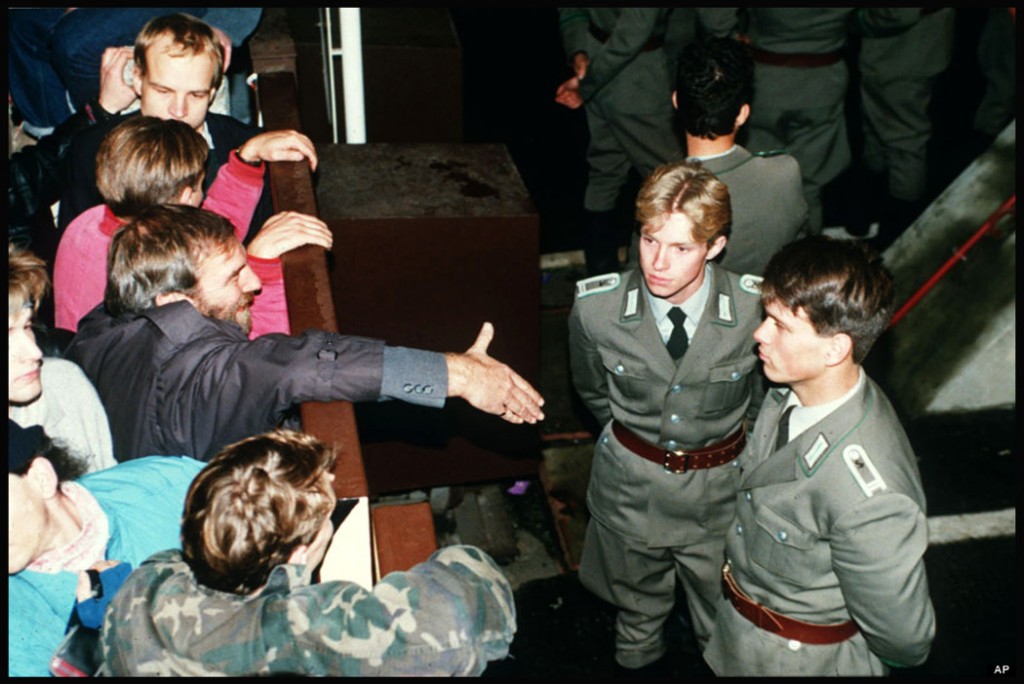 East German border policemen, right, refuse to shake hands with a Berliner who stretches out his hand over the border fence at the eastern site nearby Checkpoint Charlie border crossing point on Nov. 10, 1989. (AP Photo/Lutz Schmidt)
East German border policemen, right, refuse to shake hands with a Berliner who stretches out his hand over the border fence at the eastern site nearby Checkpoint Charlie border crossing point on Nov. 10, 1989. (AP Photo/Lutz Schmidt)
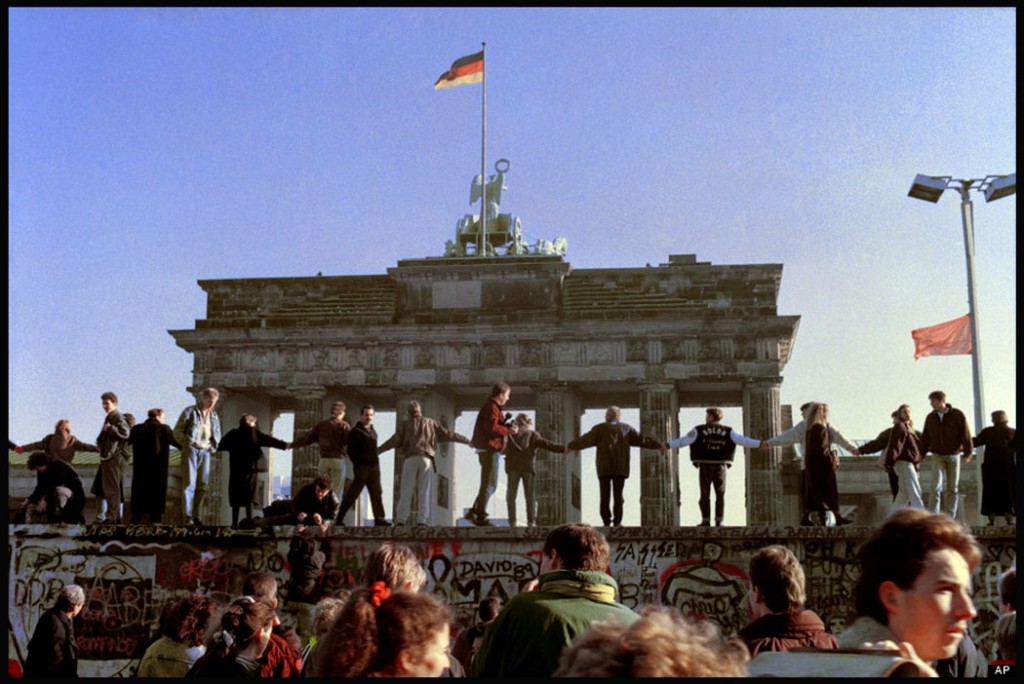 Berliners sing and dance on top of The Berlin Wall to celebrate the opening of East-West German borders in this Nov. 10, 1989 file picture. (AP Photo/Thomas Kienzle, File)
Berliners sing and dance on top of The Berlin Wall to celebrate the opening of East-West German borders in this Nov. 10, 1989 file picture. (AP Photo/Thomas Kienzle, File)
In a giant cloud of exhaust fumes of two-stroke engines, hundreds of East German cars wait bumper to bumper in front of the West German checkpoint Helmstedt to enter the west, Nov. 11, 1989. In front of the eastern checkpoint, the cars wait in line for a distance of 30-40 kilometers, a West German policeman said. The ride from Berlin to Helmstadt (about 200 kilometers) would last about 11 hours. (AP Photo/Claus Eckert)
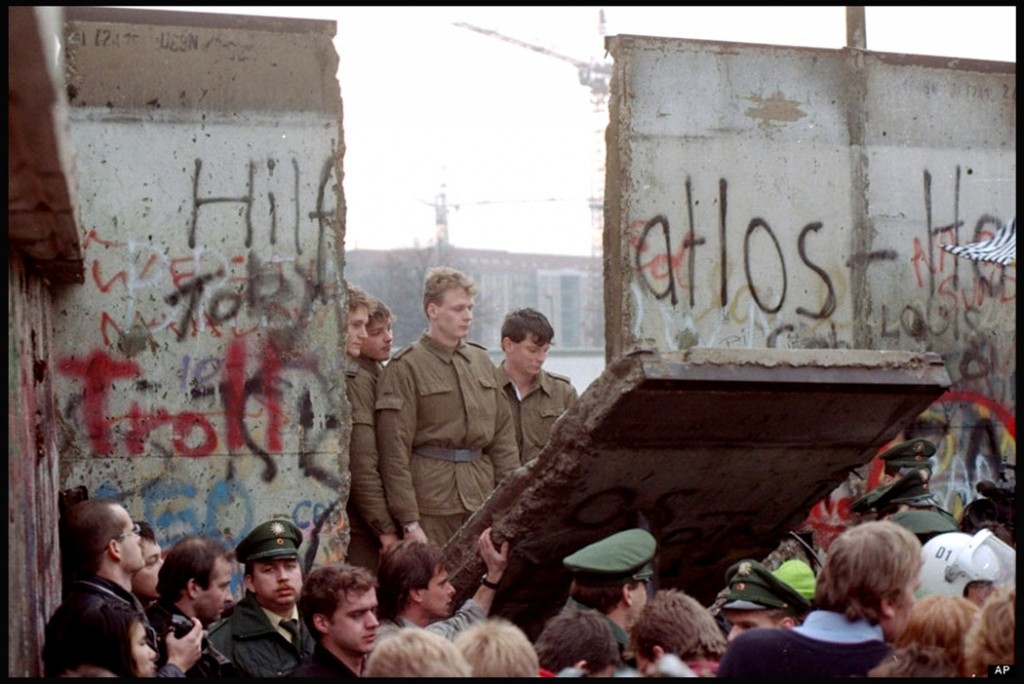 East German border guards look through a hole in the Berlin wall after demonstrators pulled down one segment of the wall at Brandenburg gate in this November 11, 1989 file picture. (AP Photo/Lionel Cironneau, File)
East German border guards look through a hole in the Berlin wall after demonstrators pulled down one segment of the wall at Brandenburg gate in this November 11, 1989 file picture. (AP Photo/Lionel Cironneau, File)
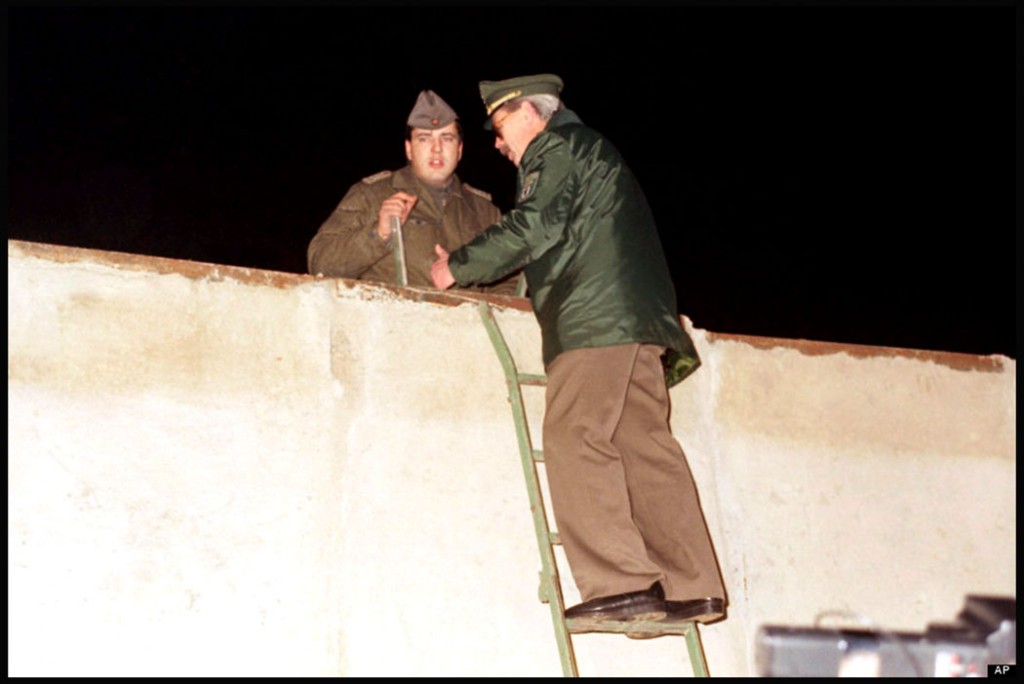 A West Berlin policeman, right, and an East German border guard stand on ladders while talking over the Berlin Wall at Bernauer Strasse in Berlin, Nov. 11, 1989, where East Germany began to pull down the wall early Saturday morning. (AP Photo)
A West Berlin policeman, right, and an East German border guard stand on ladders while talking over the Berlin Wall at Bernauer Strasse in Berlin, Nov. 11, 1989, where East Germany began to pull down the wall early Saturday morning. (AP Photo)
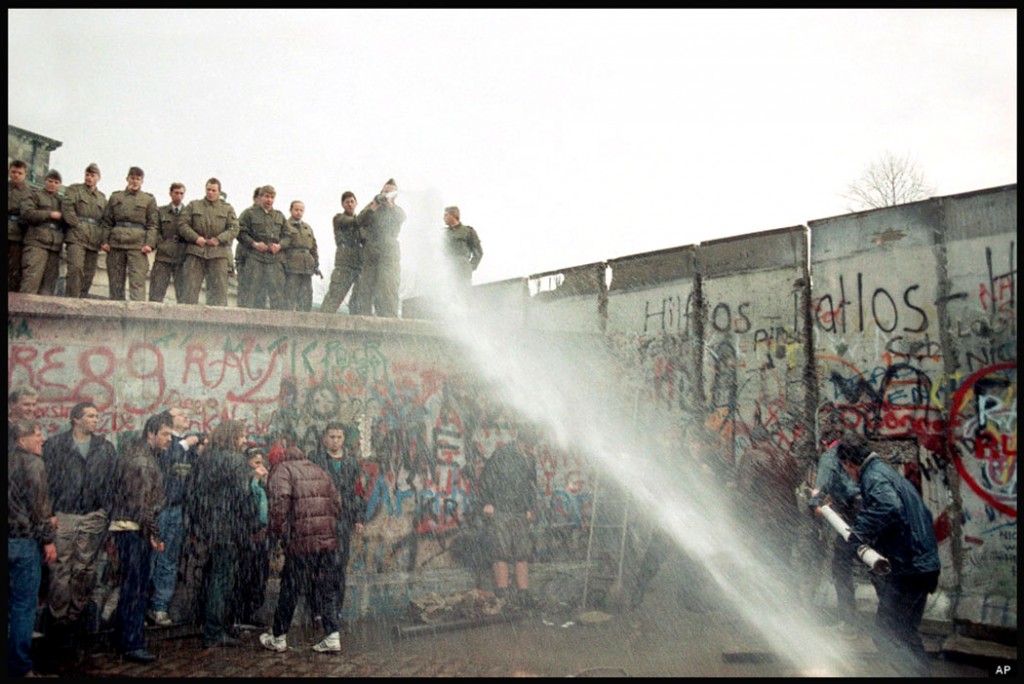 East German border guards use a hose to discourage West Berliners near Brandenburg gate, in Berlin, Nov. 11, 1989. The citizens from the west tried to demolish the wall, demanding it be pulled down. (AP Photo/Lionel Cironneau)
East German border guards use a hose to discourage West Berliners near Brandenburg gate, in Berlin, Nov. 11, 1989. The citizens from the west tried to demolish the wall, demanding it be pulled down. (AP Photo/Lionel Cironneau)
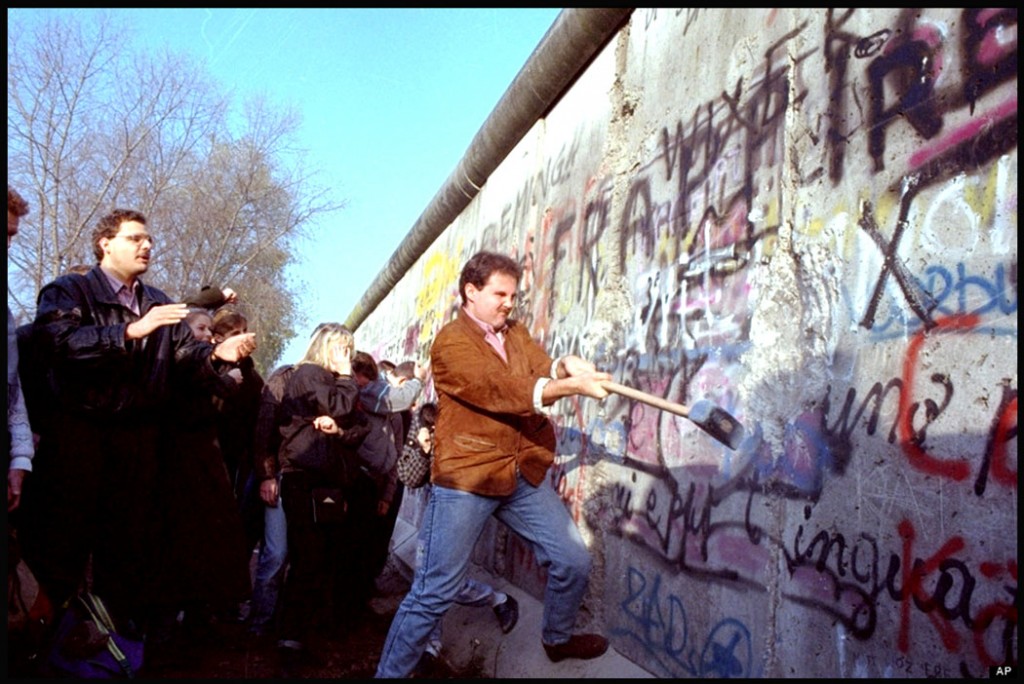 An unidentified West Berliner swings a sledgehammer, trying to destroy the Berlin Wall near Potsdamer Platz, on November 12, 1989, where a new passage was opened nearby. (AP Photo/John Gaps III)
An unidentified West Berliner swings a sledgehammer, trying to destroy the Berlin Wall near Potsdamer Platz, on November 12, 1989, where a new passage was opened nearby. (AP Photo/John Gaps III)
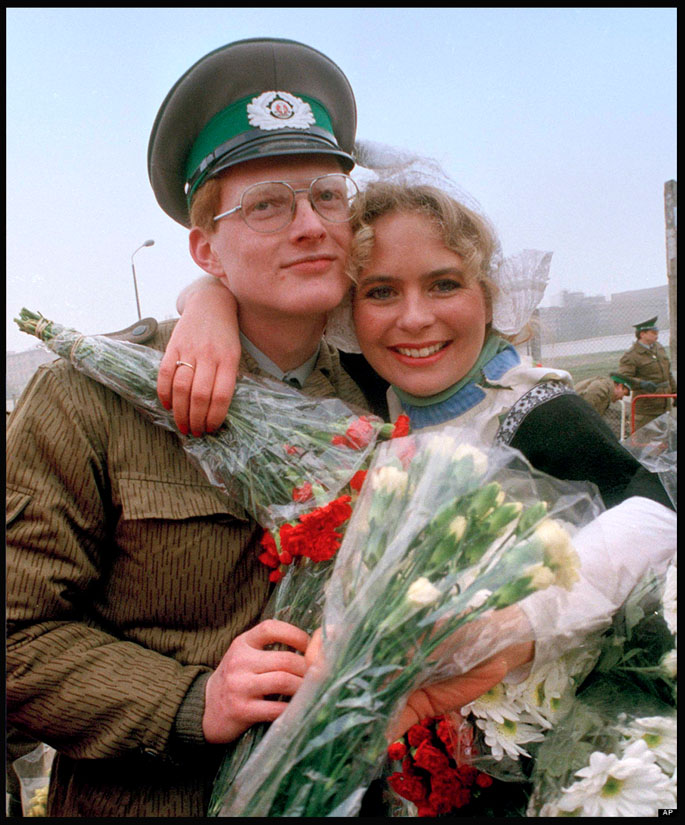 An East Berlin border guard is hugged by an unidentified Berliner at Potsdammer Platz, Nov. 12, 1989, when East Germany opened the wall to the west at this historical landmark. (AP Photo/Rainer Klostermeier)
An East Berlin border guard is hugged by an unidentified Berliner at Potsdammer Platz, Nov. 12, 1989, when East Germany opened the wall to the west at this historical landmark. (AP Photo/Rainer Klostermeier)
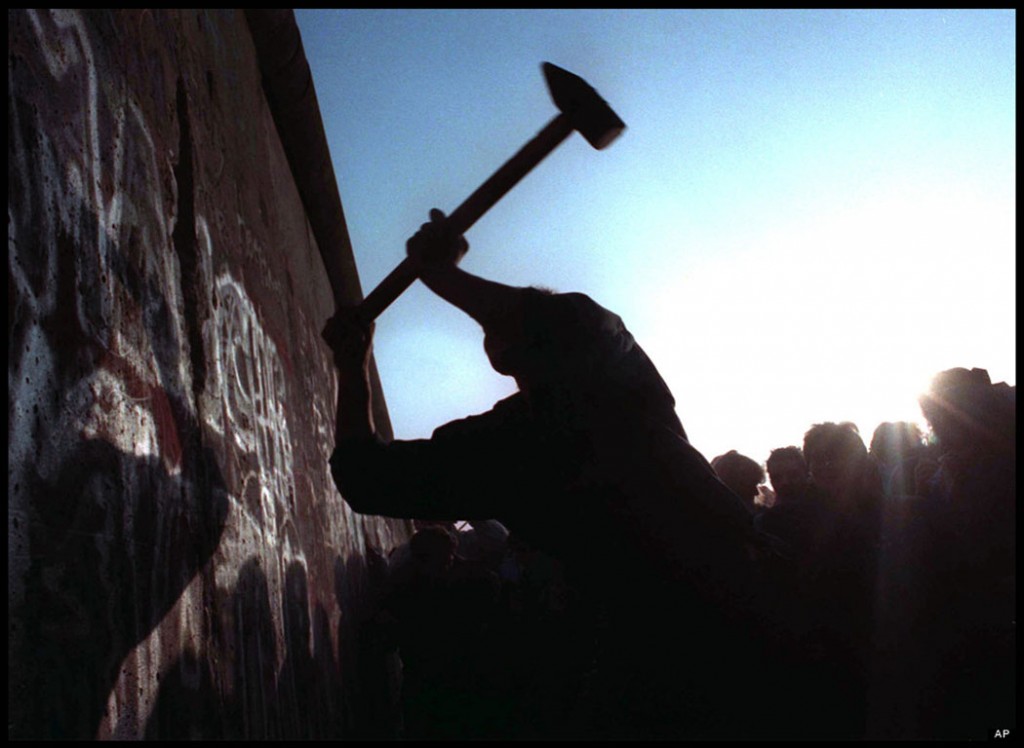 A man hammers away at the Berlin Wall, as the border barrier between East and West Germany was torn down after 28 years, in this Nov. 12, 1989 file picture. (AP Photo/John Gaps III, File)
A man hammers away at the Berlin Wall, as the border barrier between East and West Germany was torn down after 28 years, in this Nov. 12, 1989 file picture. (AP Photo/John Gaps III, File)
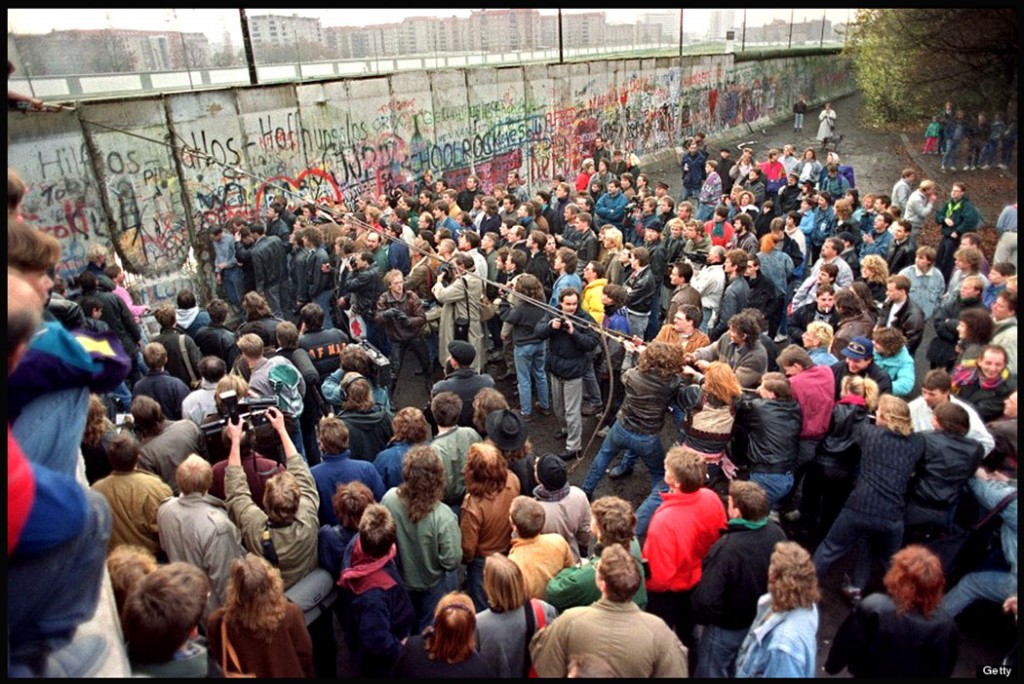 West Berliners crowd in front of the Berlin Wall early 11 November 1989 as they watch people trying to demolish a section of the wall in order to open a new crossing point between East and West Berlin, near the Potsdamer Square. (GERARD MALIE/AFP/Getty Images)
West Berliners crowd in front of the Berlin Wall early 11 November 1989 as they watch people trying to demolish a section of the wall in order to open a new crossing point between East and West Berlin, near the Potsdamer Square. (GERARD MALIE/AFP/Getty Images)
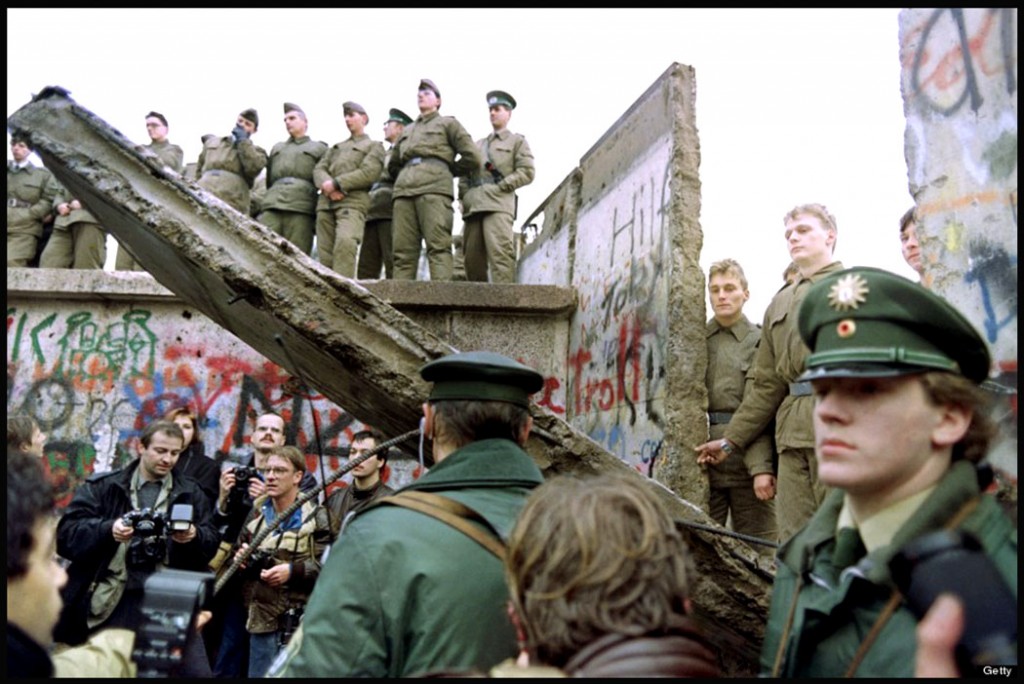 Two West German policemen prevent people from approaching as East German Vopos stand on and near a fallen portion of the Berlin Wall 11 November 1989. (GERARD MALIE/AFP/Getty Images)
Two West German policemen prevent people from approaching as East German Vopos stand on and near a fallen portion of the Berlin Wall 11 November 1989. (GERARD MALIE/AFP/Getty Images)
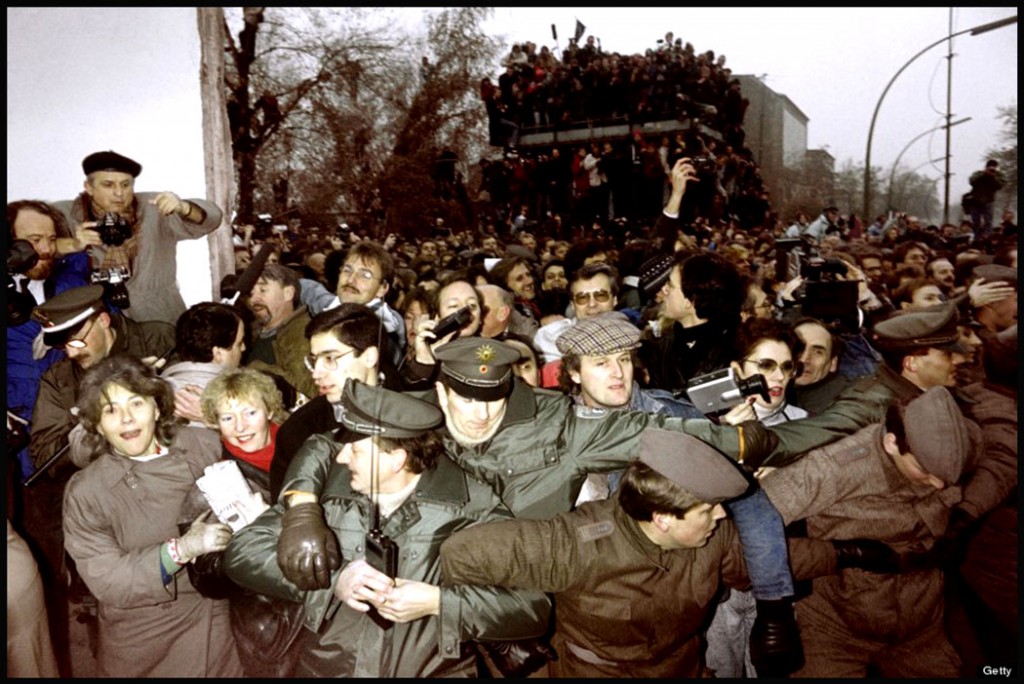 East and West German Police contain the crowd of East Berliners flowing through the recent opening made in the Berlin wall at Potsdamer Square, on November 12, 1989. (PATRICK HERTZOG/AFP/Getty Images)
East and West German Police contain the crowd of East Berliners flowing through the recent opening made in the Berlin wall at Potsdamer Square, on November 12, 1989. (PATRICK HERTZOG/AFP/Getty Images)
Thousands of young East Berliners crowd atop the Berlin Wall, near the Brandenburg Gate (background) on November 11, 1989. (GERARD MALIE/AFP/Getty Images)
Please visit the following links for more information:
https://www.huffingtonpost.com/2014/11/09/berlin-wall-anniversary-photos_n_6094308.html?utm_hp_ref=world&ir=WorldPost
Berlin Berlin Wall Berlin Wall Anniversary Berlin Wall Fall Berlin Wall Fall Anniversary Berlin Wall Photos Berlin Wall Fall Photos
Around the Web
The Berlin Wall fell 25 years ago, but Germany is still divided – The …
Fall of the Berlin Wall 25th Anniversary: Pictorial History of the Wall …
The Fall of the Berlin Wall – Photo 1 – Pictures – CBS News
The Berlin Wall in the cold war and now – interactive
Walk the line: Will Self retraces the Berlin Wall, 25 years after its fall
Berlin Wall Now in Pieces Scattered Around the Globe
UW Faculty Recital Series Celebrates 25th Anniversary of Berlin Wall’s Fall
Berlin city guide: what to see plus the best bars, restaurants and hotels
https://www.boston.com/bigpicture/2011/08/remembering_the_divide.html
Boston.com
Remembering the Berlin Wall
In 1961, East Germany erected a wall — initially barbed wire, eventually concrete — in the middle of Berlin to prevent its citizens from fleeing the communist country to West Germany during the height of the Cold War. It has been reported that 136 people died while trying to escape, but the total number is unknown. The wall finally came down at the beginning of November in 1989, part of the reunification of East and West Germany. Here are images from this past weekend’s recognition of the construction of the wall 50 years ago, as well as historic images. — Lloyd Young (30 photos total)
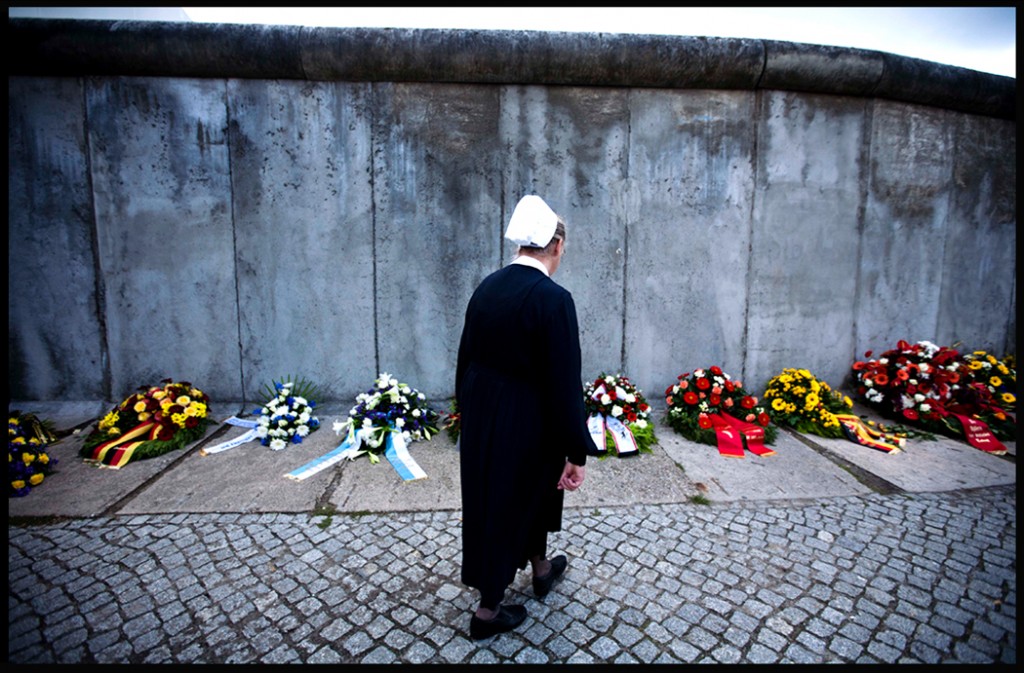 A nun walks in front of a line of wreaths during the commemoration of the 50th anniversary of the construction of the Berlin Wall at the Berlin Wall Memorial at Bernauer Strasse in Berlin Aug. 13. Germany marks the 50th anniversary of the day communist East Germany sealed itself off behind the Wall. Germany had been divided into capitalist western and communist eastern sectors after the end of World War II. At the height of tensions between the United States and the Soviet Union, the East German regime started building the wall through the capital on Aug. 13, 1961. (Markus Schreiber/Associated Press)
A nun walks in front of a line of wreaths during the commemoration of the 50th anniversary of the construction of the Berlin Wall at the Berlin Wall Memorial at Bernauer Strasse in Berlin Aug. 13. Germany marks the 50th anniversary of the day communist East Germany sealed itself off behind the Wall. Germany had been divided into capitalist western and communist eastern sectors after the end of World War II. At the height of tensions between the United States and the Soviet Union, the East German regime started building the wall through the capital on Aug. 13, 1961. (Markus Schreiber/Associated Press)
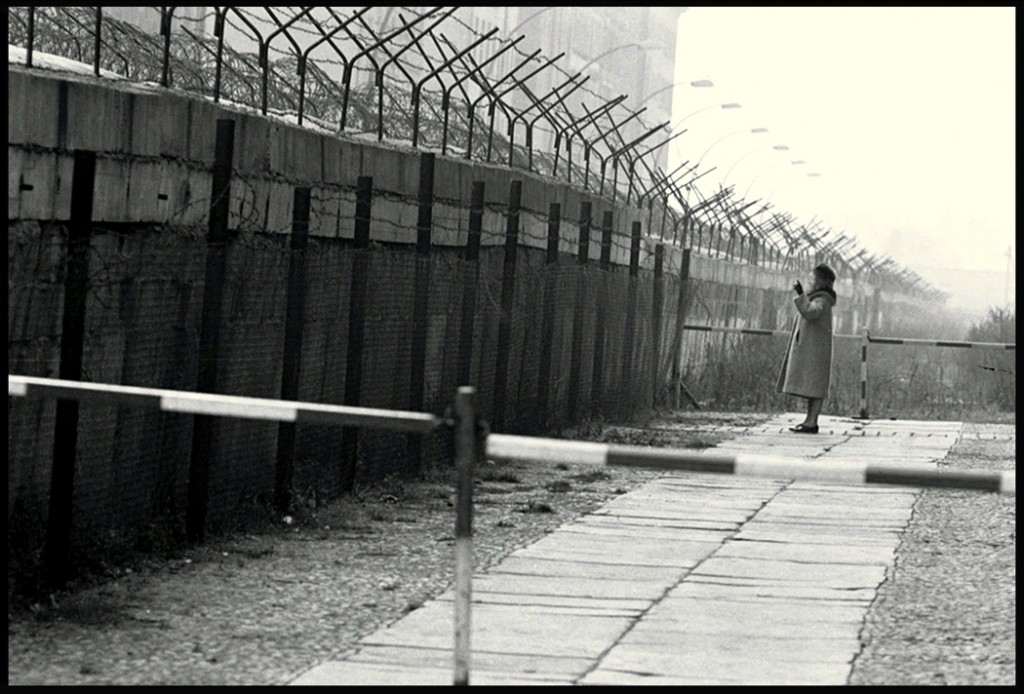 A West Berliner stands at the foot of the Berlin Wall while talking to an East Berliner in this 1962. (KRT)
A West Berliner stands at the foot of the Berlin Wall while talking to an East Berliner in this 1962. (KRT)
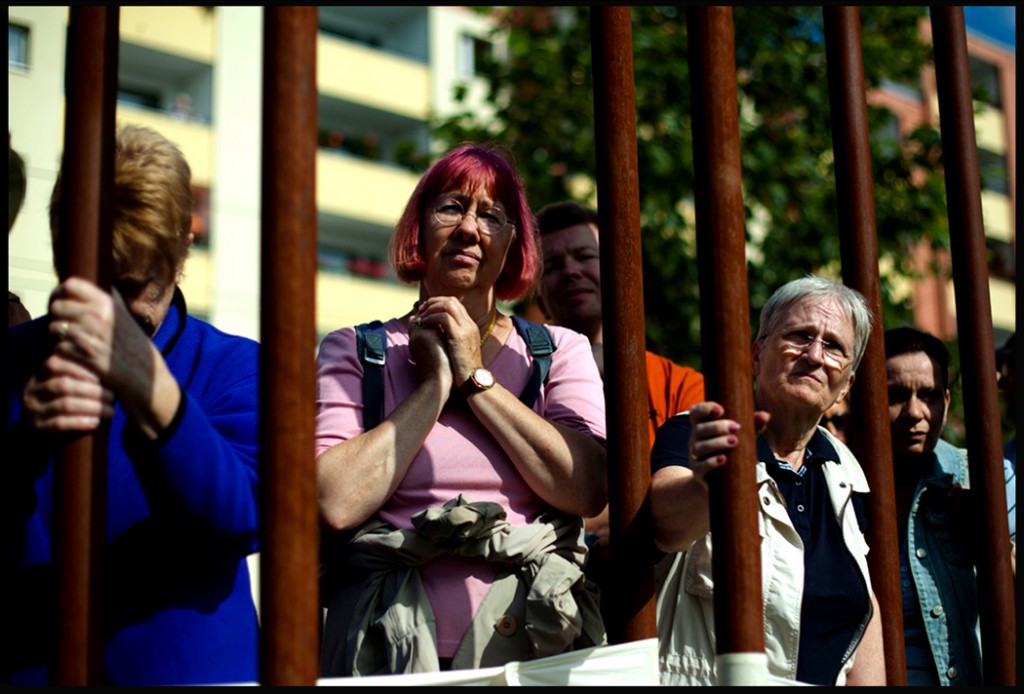 Spectators stand at the Berlin Wall Memorial at Bernauer Strasse in Berlin Aug. 13. (Markus Schreiber/Associated Press)
Spectators stand at the Berlin Wall Memorial at Bernauer Strasse in Berlin Aug. 13. (Markus Schreiber/Associated Press)
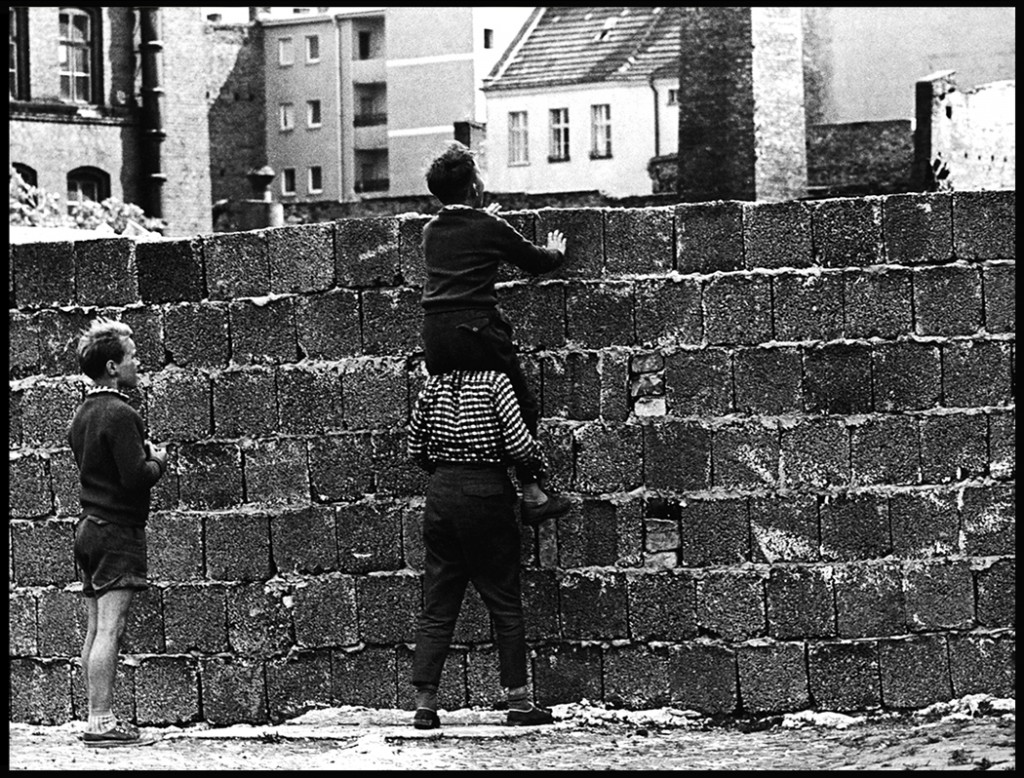 A boy sitting on the shoulders of another child peers at the Liesen street in Wedding, West Berlin, over the wall towards the eastern part of the city Aug. 23, 1961. (Werner Kreusch/Associated Press)
A boy sitting on the shoulders of another child peers at the Liesen street in Wedding, West Berlin, over the wall towards the eastern part of the city Aug. 23, 1961. (Werner Kreusch/Associated Press)
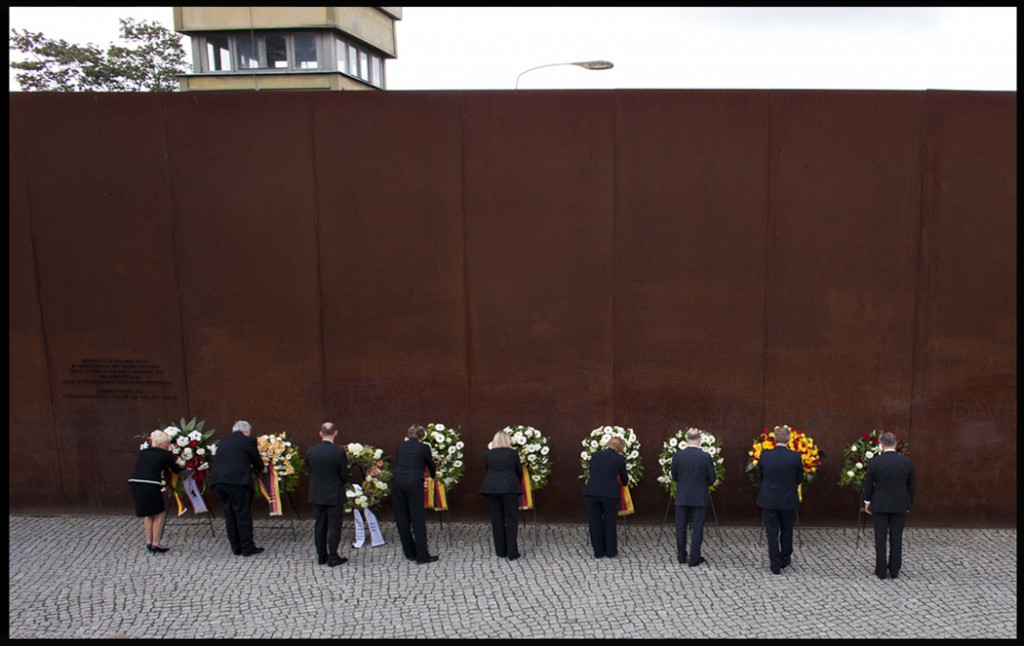 German Chancellor Angela Merkel, Berlin’s Major Klaus Wowereit, Germany’s President Christian Wulff and Axel Klausmeier, Director of the Berlin Wall Foundation, lay down floral wreaths during a commemorative ceremony of the construction of the Berlin Wall at the Bernauer Strasse Memorial in Berlin on Aug. 13. Berlin marked the 50th anniversary of the building of the Berlin Wall with a memorial service and a minute of silence in memory of those who died trying to flee to the West. (Carsten Koall/AFP/Getty Images)
German Chancellor Angela Merkel, Berlin’s Major Klaus Wowereit, Germany’s President Christian Wulff and Axel Klausmeier, Director of the Berlin Wall Foundation, lay down floral wreaths during a commemorative ceremony of the construction of the Berlin Wall at the Bernauer Strasse Memorial in Berlin on Aug. 13. Berlin marked the 50th anniversary of the building of the Berlin Wall with a memorial service and a minute of silence in memory of those who died trying to flee to the West. (Carsten Koall/AFP/Getty Images)
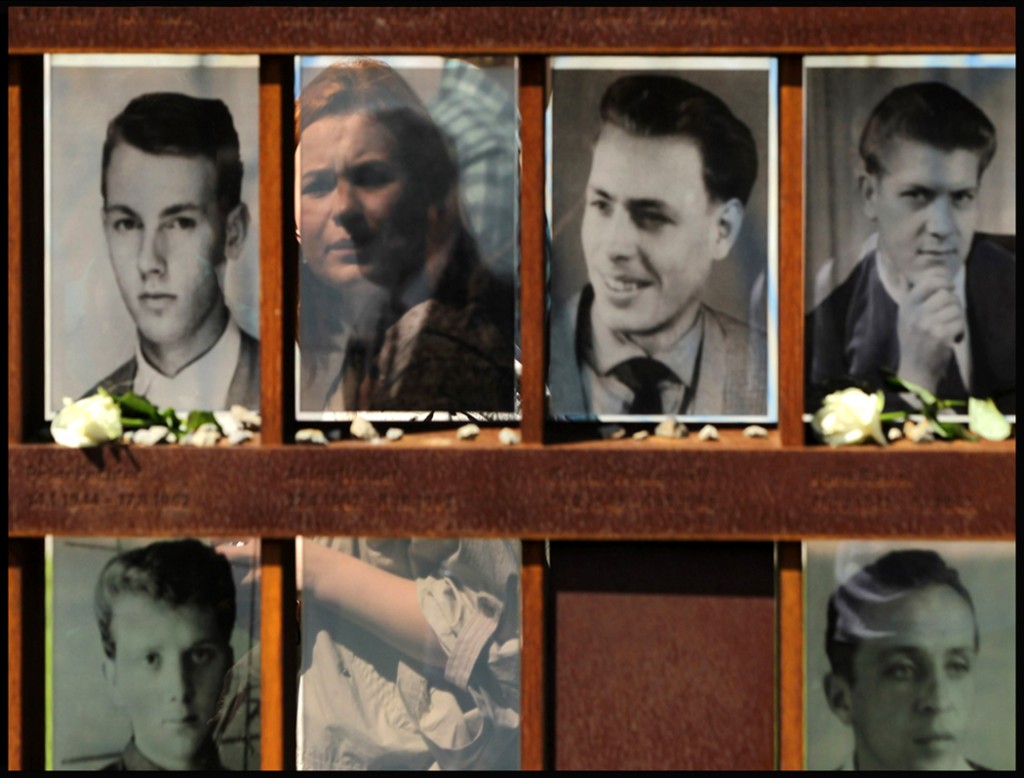 A young woman is seen through semi-transparent portraits of people who were killed trying to cross from east to west across the Berlin Wall on the 50th anniversary of the construction of the Berlin Wall at the Bernauer Strasse memorial on Aug. 13. (Sean Gallup/Getty Images)
A young woman is seen through semi-transparent portraits of people who were killed trying to cross from east to west across the Berlin Wall on the 50th anniversary of the construction of the Berlin Wall at the Bernauer Strasse memorial on Aug. 13. (Sean Gallup/Getty Images)
 A man took a photo at the Berlin Wall Memorial at Bernauer Strasse in Berlin, during the commemorative ceremony of the construction of the Berlin Wall on Aug. 13. Berlin marked the 50th anniversary of the building of the Berlin Wall with a memorial service and a minute of silence in memory of those who died trying to flee to the West. (Michele Tantussi/AFP/Getty Images)
A man took a photo at the Berlin Wall Memorial at Bernauer Strasse in Berlin, during the commemorative ceremony of the construction of the Berlin Wall on Aug. 13. Berlin marked the 50th anniversary of the building of the Berlin Wall with a memorial service and a minute of silence in memory of those who died trying to flee to the West. (Michele Tantussi/AFP/Getty Images)
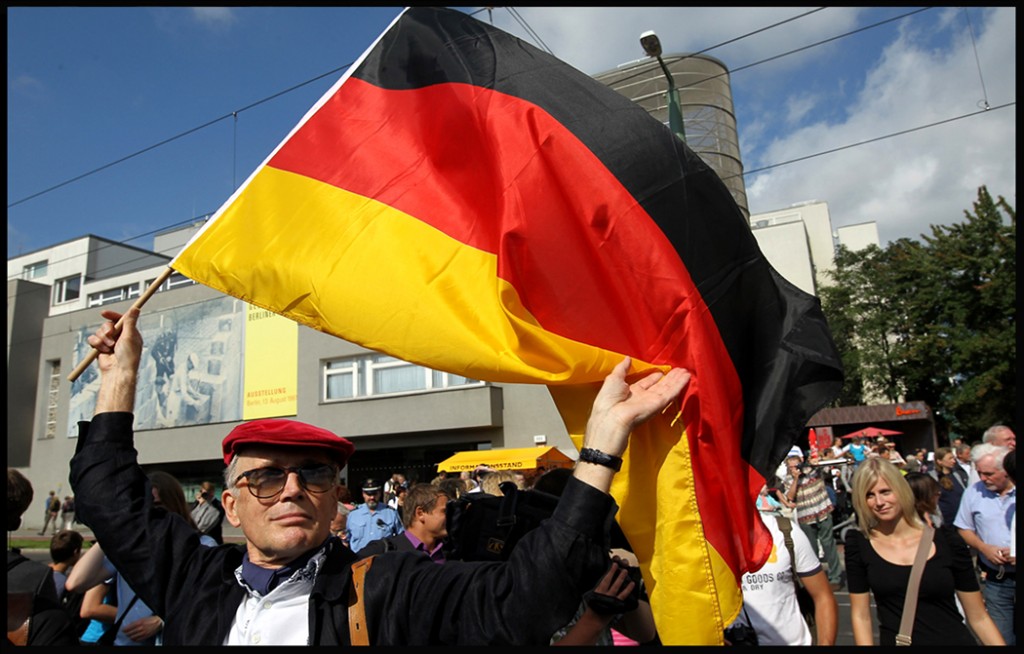 A man holding a German flag attends a ceremony commemorating the 50th anniversary of the construction of the Berlin Wall at the Bernauer Strasse memorial on Aug. 13. (Sean Gallup/Getty Images)
A man holding a German flag attends a ceremony commemorating the 50th anniversary of the construction of the Berlin Wall at the Bernauer Strasse memorial on Aug. 13. (Sean Gallup/Getty Images)
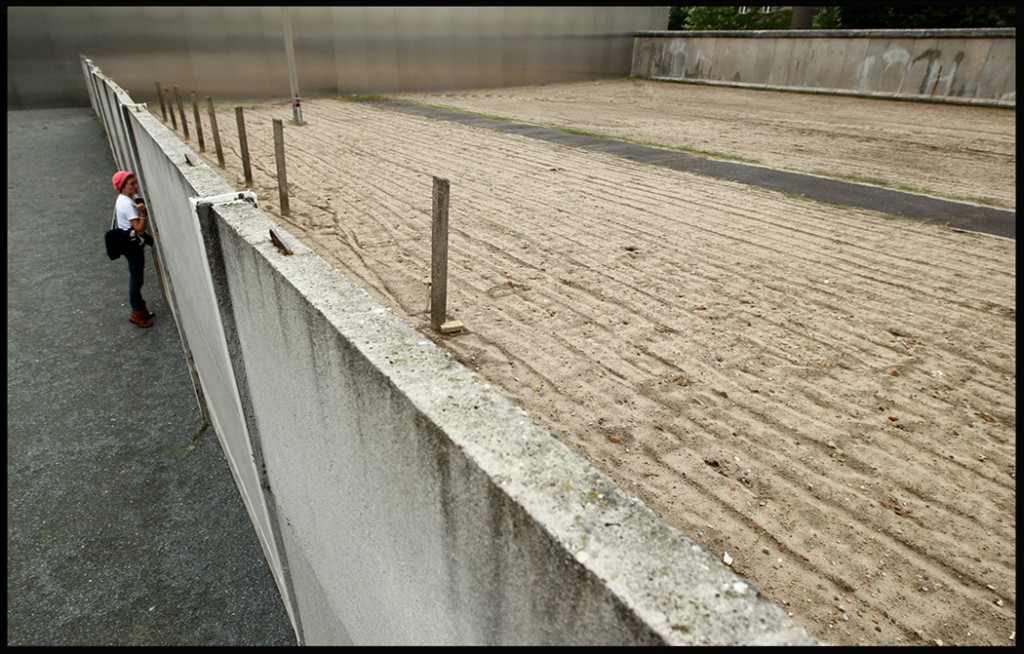 A visitor peeks through a still-existing section of the Berlin Wall into the so-called ‘death strip,’ where East German border guards had the order to shoot anyone attempting to flee into West Berlin at the Bernauer Strasse memorial on Aug. 5. (Sean Gallup/Getty Images)
A visitor peeks through a still-existing section of the Berlin Wall into the so-called ‘death strip,’ where East German border guards had the order to shoot anyone attempting to flee into West Berlin at the Bernauer Strasse memorial on Aug. 5. (Sean Gallup/Getty Images)
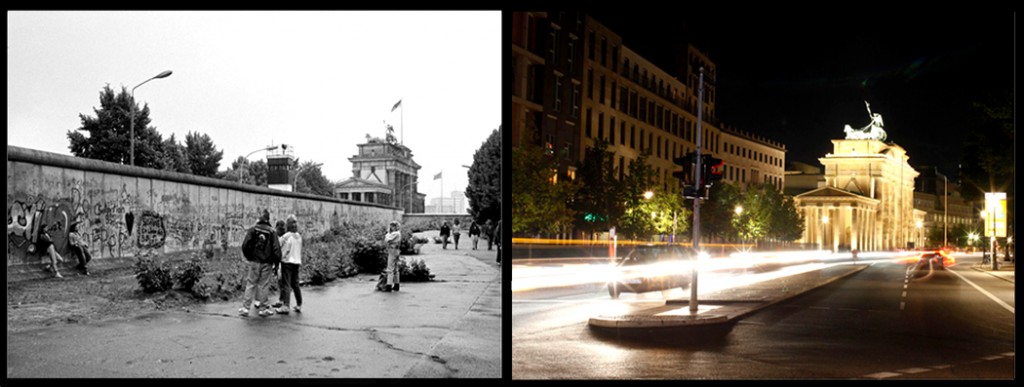 A combination photo shows people posing at the Berlin Wall at the Brandenburg Gate in Berlin in this June 6, 1989 file image (left) and a general view of Ebertstrasse and the Brandenburg Gate in Berlin, Aug. 3, 2011. (Fabrizio Bensch/Reuters)
A combination photo shows people posing at the Berlin Wall at the Brandenburg Gate in Berlin in this June 6, 1989 file image (left) and a general view of Ebertstrasse and the Brandenburg Gate in Berlin, Aug. 3, 2011. (Fabrizio Bensch/Reuters)
 Tourists posing in front of the Berlin Wall at the Brandenburg gate in Berlin in this June 6, 1989 (left) and a general view of the Brandenburg gate Aug. 3, 2011. (Fabrizio Bensch/Reuters)
Tourists posing in front of the Berlin Wall at the Brandenburg gate in Berlin in this June 6, 1989 (left) and a general view of the Brandenburg gate Aug. 3, 2011. (Fabrizio Bensch/Reuters)
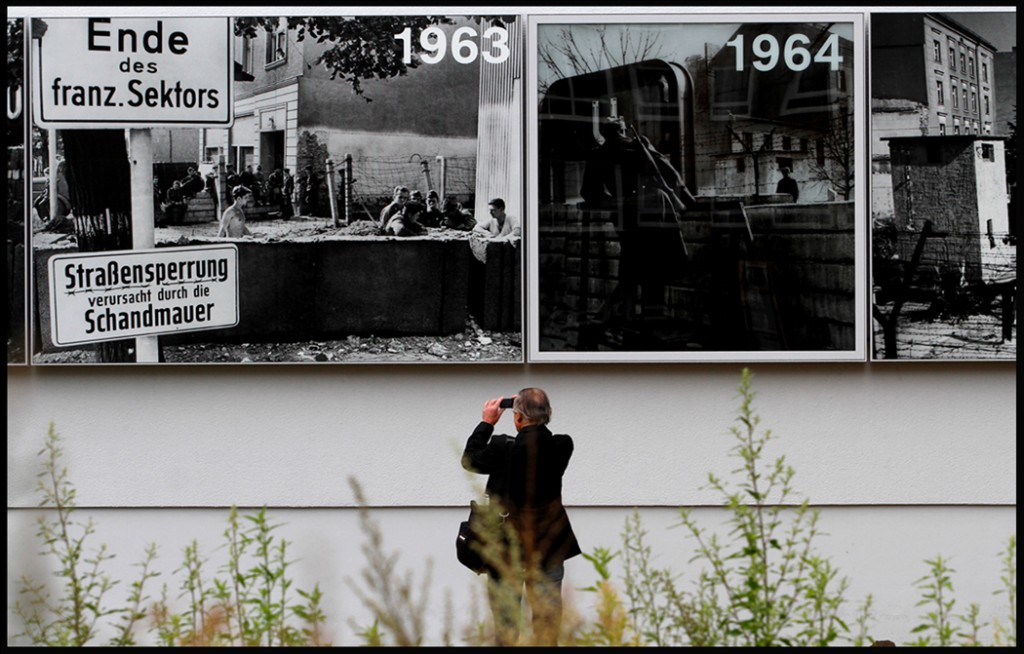 A man takes pictures of exhibited photographs of the Berlin Wall at Bernauer Strasse in Berlin during the commemorative ceremony of the construction of the Berlin Wall on Aug. 13. (Michele Tantussi/AFP/Getty Images)
A man takes pictures of exhibited photographs of the Berlin Wall at Bernauer Strasse in Berlin during the commemorative ceremony of the construction of the Berlin Wall on Aug. 13. (Michele Tantussi/AFP/Getty Images)
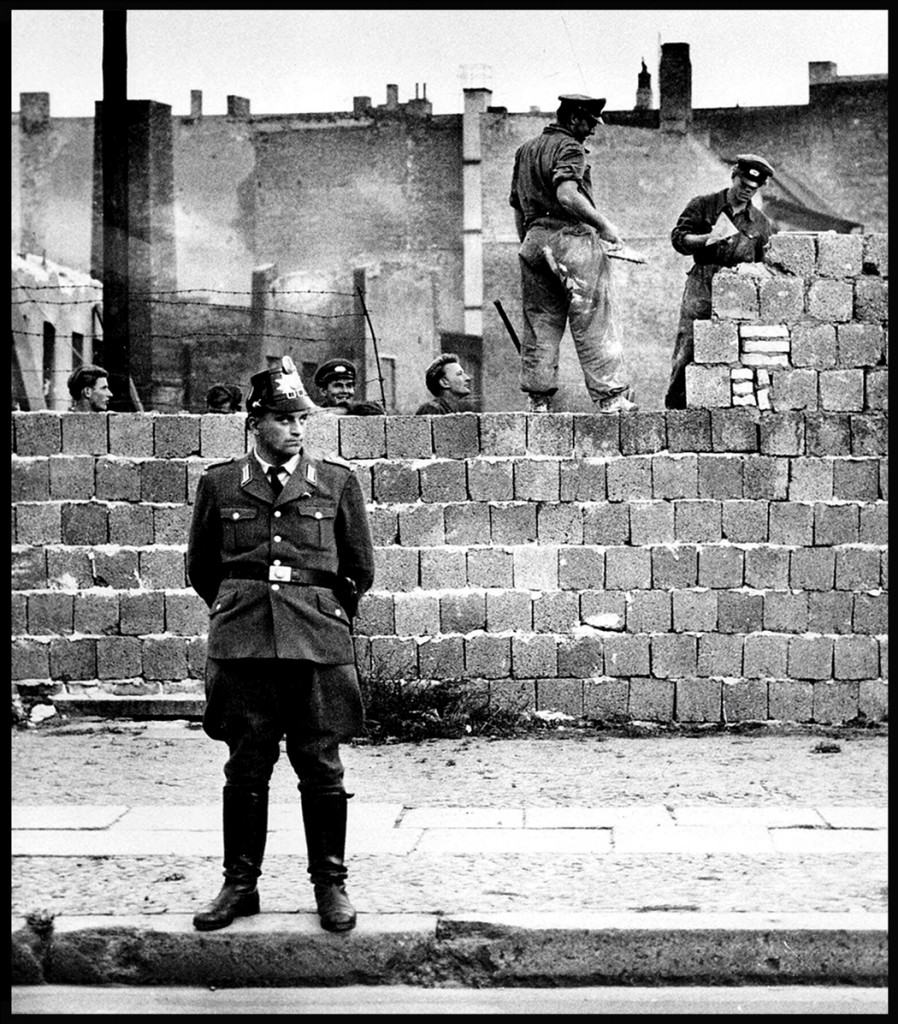 A West Berlin police officer stands in front of the concrete wall dividing East and West Berlin at Bernauer Strasse as East Berlin workers add blocks to increase the height of the East German barrier Oct. 7, 1961. (Associated Press)
A West Berlin police officer stands in front of the concrete wall dividing East and West Berlin at Bernauer Strasse as East Berlin workers add blocks to increase the height of the East German barrier Oct. 7, 1961. (Associated Press)
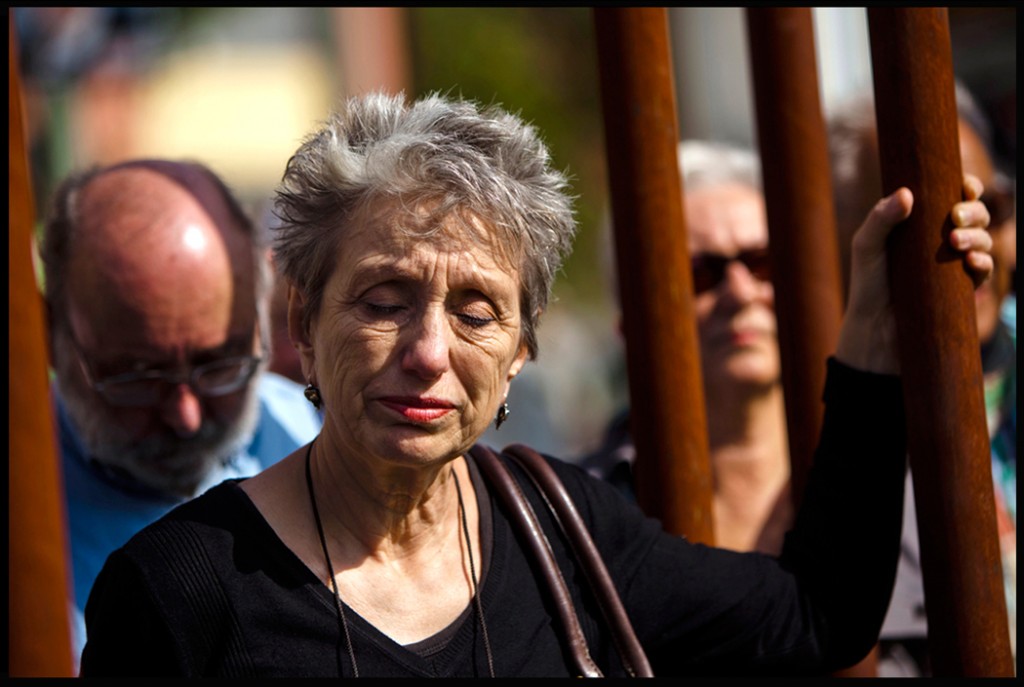 Sylvia von Scheidt reacts at the Berlin Wall Memorial at Bernauer Strasse in Berlin Aug. 13. Germany marks the 50th anniversary of the day communist East Germany sealed itself off behind the Berlin Wall. Germany had been divided into capitalist western and communist eastern sectors after the end of World War II. At the height of tensions between the United States and the Soviet Union, the East German regime started building the wall through the capital on Aug. 13, 1961. (Markus Schreiber/Associated Press)
Sylvia von Scheidt reacts at the Berlin Wall Memorial at Bernauer Strasse in Berlin Aug. 13. Germany marks the 50th anniversary of the day communist East Germany sealed itself off behind the Berlin Wall. Germany had been divided into capitalist western and communist eastern sectors after the end of World War II. At the height of tensions between the United States and the Soviet Union, the East German regime started building the wall through the capital on Aug. 13, 1961. (Markus Schreiber/Associated Press)
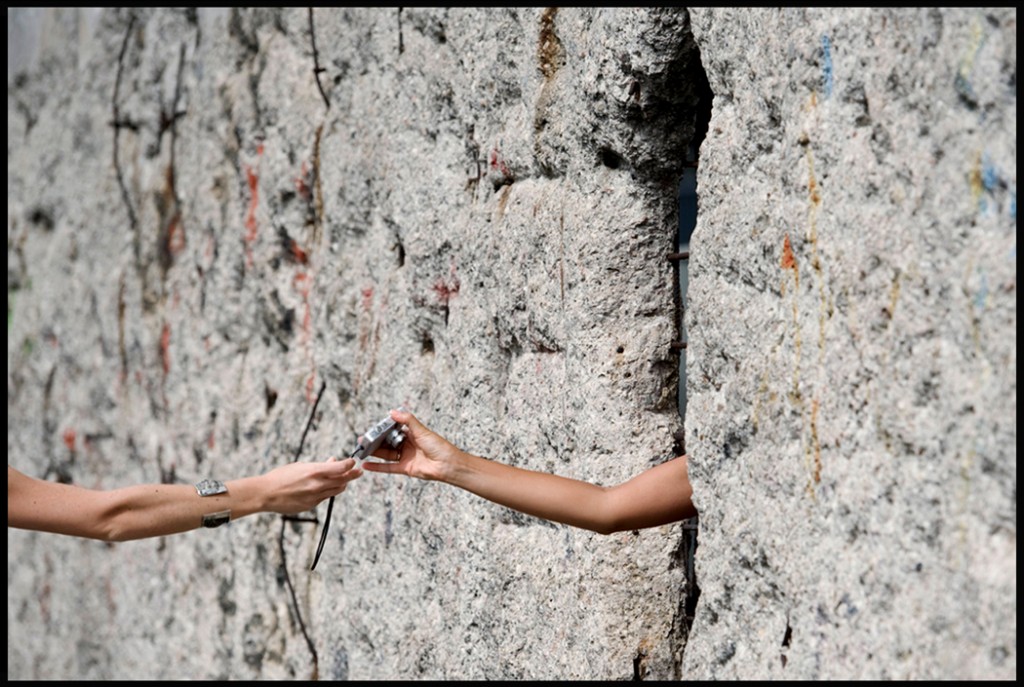 Visitors pass a camera through a hole in a remaining part of the Berlin Wall at the Documentation Center for Nazi Crimes in Berlin Aug. 13. ( Steffi Loos/Associated Press)
Visitors pass a camera through a hole in a remaining part of the Berlin Wall at the Documentation Center for Nazi Crimes in Berlin Aug. 13. ( Steffi Loos/Associated Press)
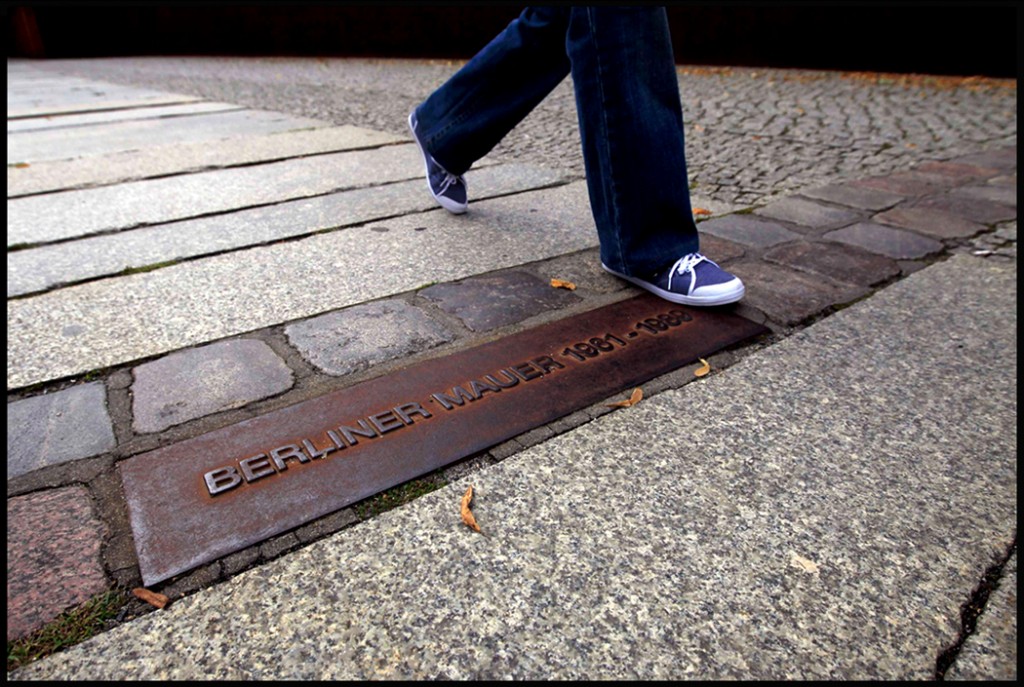 A person walks across the plaque and a line of bricks that show where the Berlin Wall used to stand at the Berlin Wall memorial site in Bernauer Strasse, Aug. 9. The German capital is preparing to mark the 50th anniversary of the building of the Berlin Wall, which was erected on Aug. 13, 1961. (Thomas Peter/Reuters)
A person walks across the plaque and a line of bricks that show where the Berlin Wall used to stand at the Berlin Wall memorial site in Bernauer Strasse, Aug. 9. The German capital is preparing to mark the 50th anniversary of the building of the Berlin Wall, which was erected on Aug. 13, 1961. (Thomas Peter/Reuters)
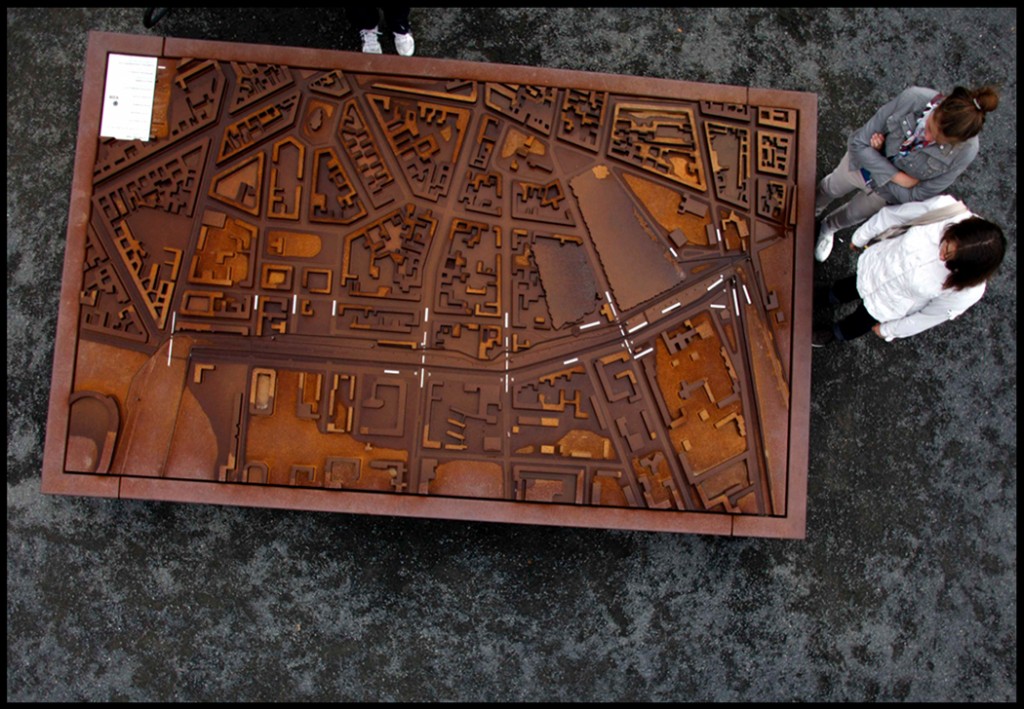 People look at the map showing the location of the Berlin Wall within the limits of Bernauer Strasse at the memorial site in Bernauer Strasse in Berlin, Aug. 11. (Pawel Kopczynski/Reuters)
People look at the map showing the location of the Berlin Wall within the limits of Bernauer Strasse at the memorial site in Bernauer Strasse in Berlin, Aug. 11. (Pawel Kopczynski/Reuters)
 Tourists look through a part of the former Berlin Wall fortification at the Berlin Wall memorial site in Bernauer Strasse, Aug. 9. (Thomas Peter/Reuters)
Tourists look through a part of the former Berlin Wall fortification at the Berlin Wall memorial site in Bernauer Strasse, Aug. 9. (Thomas Peter/Reuters)
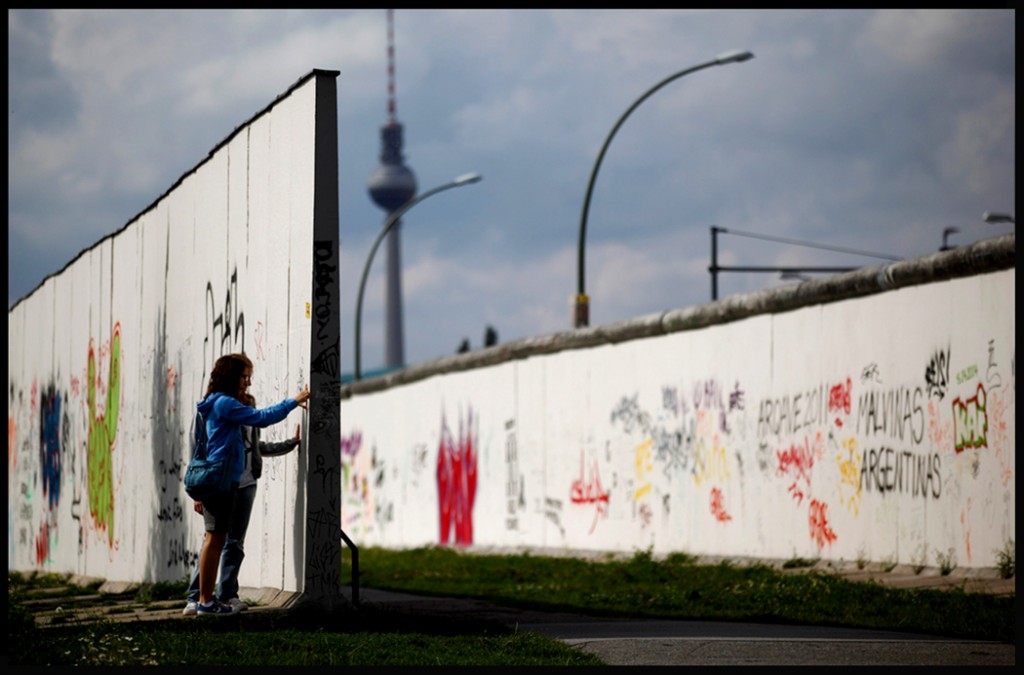 A tourist walked in front of a segment of the graffiti painted wall at the East Side Gallery in Berlin, Aug. 12. (Pawel Kopczynski/Reuters)
A tourist walked in front of a segment of the graffiti painted wall at the East Side Gallery in Berlin, Aug. 12. (Pawel Kopczynski/Reuters)
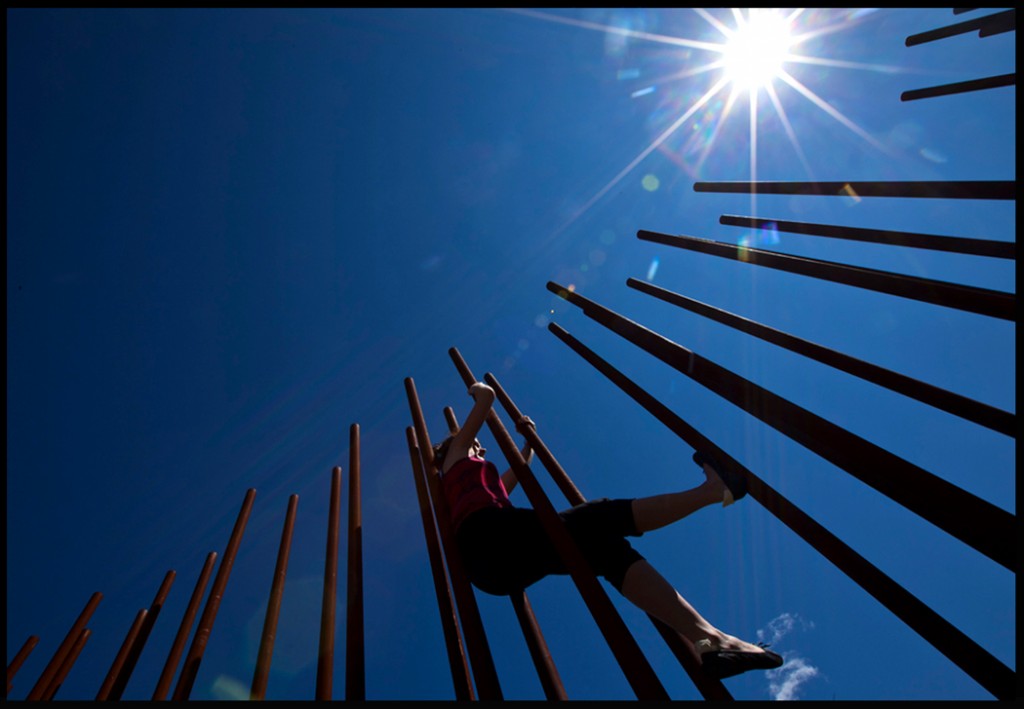 An artist performs between iron bars during a rehearsal in Berlin, Germany, Aug. 8. The performance “Between the bricks” directed by Jo Parks will be shown during the remembrance celebrations for the 50th anniversary of the building of the Berlin Wall on Aug. 13. The iron bars symbolize the Berlin Wall and are set up where the original Wall stood at the Wall Memorial at Bernauer Strasse. (Markus Schreiber/Associated Press)
An artist performs between iron bars during a rehearsal in Berlin, Germany, Aug. 8. The performance “Between the bricks” directed by Jo Parks will be shown during the remembrance celebrations for the 50th anniversary of the building of the Berlin Wall on Aug. 13. The iron bars symbolize the Berlin Wall and are set up where the original Wall stood at the Wall Memorial at Bernauer Strasse. (Markus Schreiber/Associated Press)
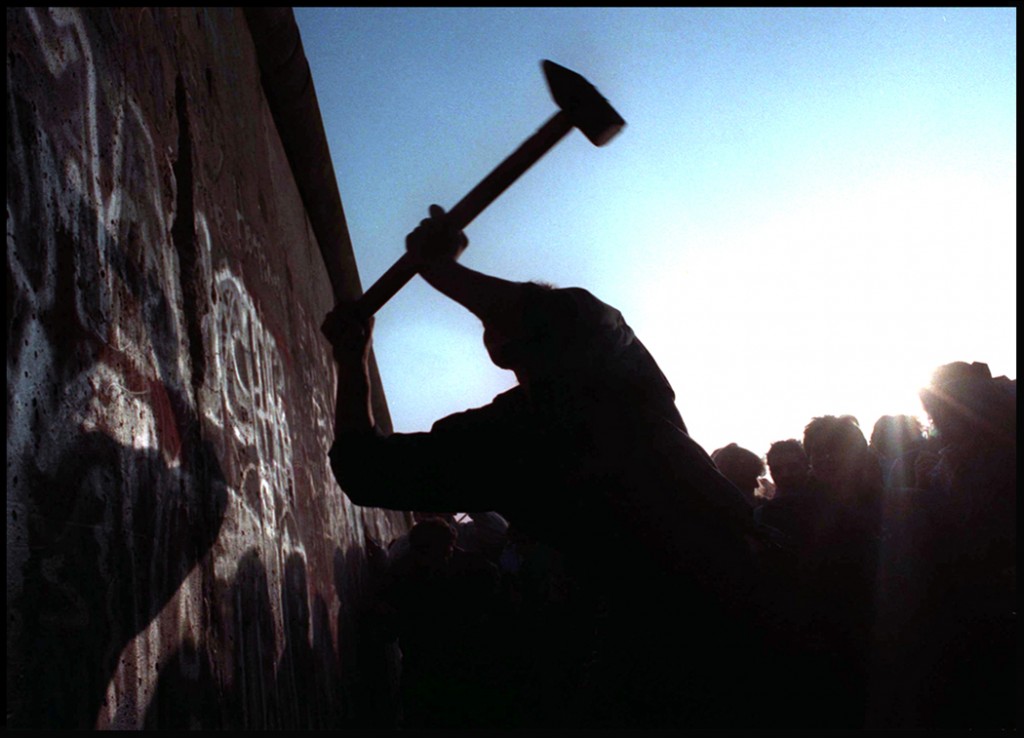 A man hammering at the Berlin Wall, as the border barrier between East and West Germany was torn down after 28 years. on Nov. 12, 1989. (John Gaps III, Associated Press)
A man hammering at the Berlin Wall, as the border barrier between East and West Germany was torn down after 28 years. on Nov. 12, 1989. (John Gaps III, Associated Press)
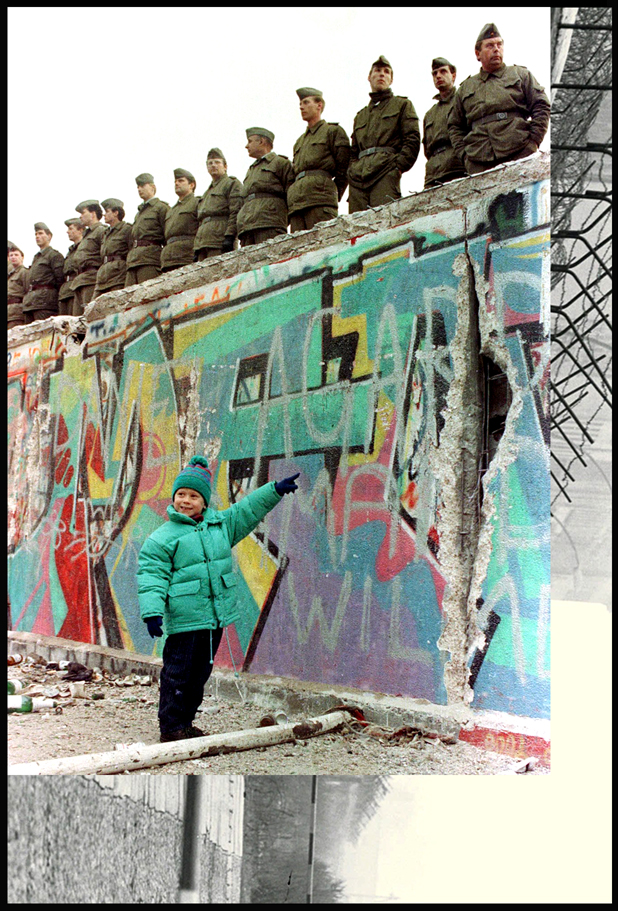 A young West German girl smiling at her father as she points to a large hole in the Berlin Wall Nov. 11, 1989. The German capital is preparing to mark the 50th anniversary of the building of the Berlin Wall, which was erected on Aug. 13, 1961. (Reuters)
A young West German girl smiling at her father as she points to a large hole in the Berlin Wall Nov. 11, 1989. The German capital is preparing to mark the 50th anniversary of the building of the Berlin Wall, which was erected on Aug. 13, 1961. (Reuters)
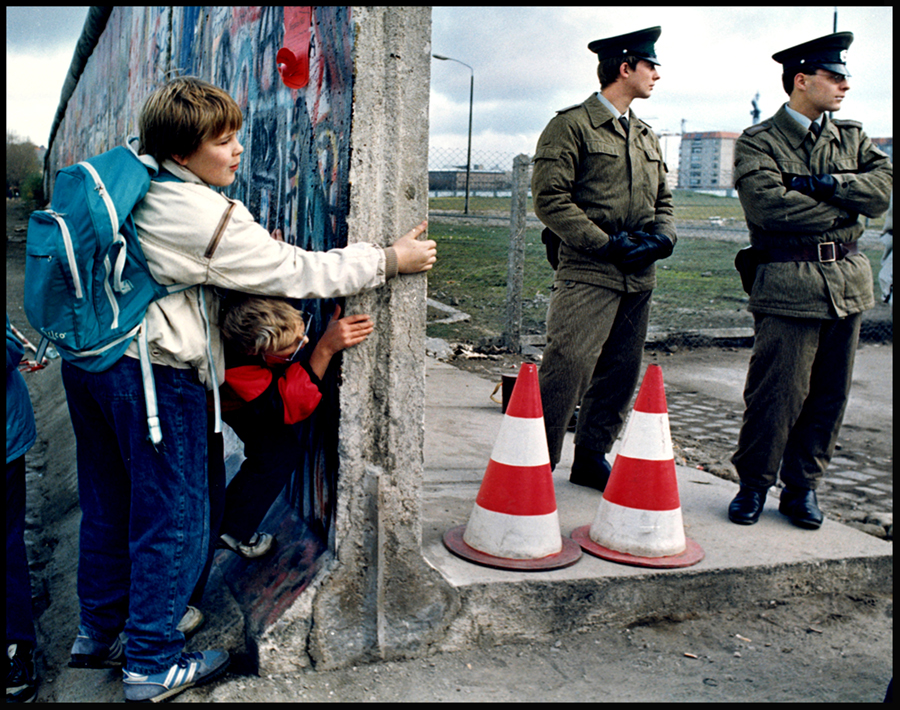 West Berlin youngsters peer through an opening in the wall at Postdammer Platz as East German border guards stand and watch. (John Tlumacki/The Boston Globe)
West Berlin youngsters peer through an opening in the wall at Postdammer Platz as East German border guards stand and watch. (John Tlumacki/The Boston Globe)
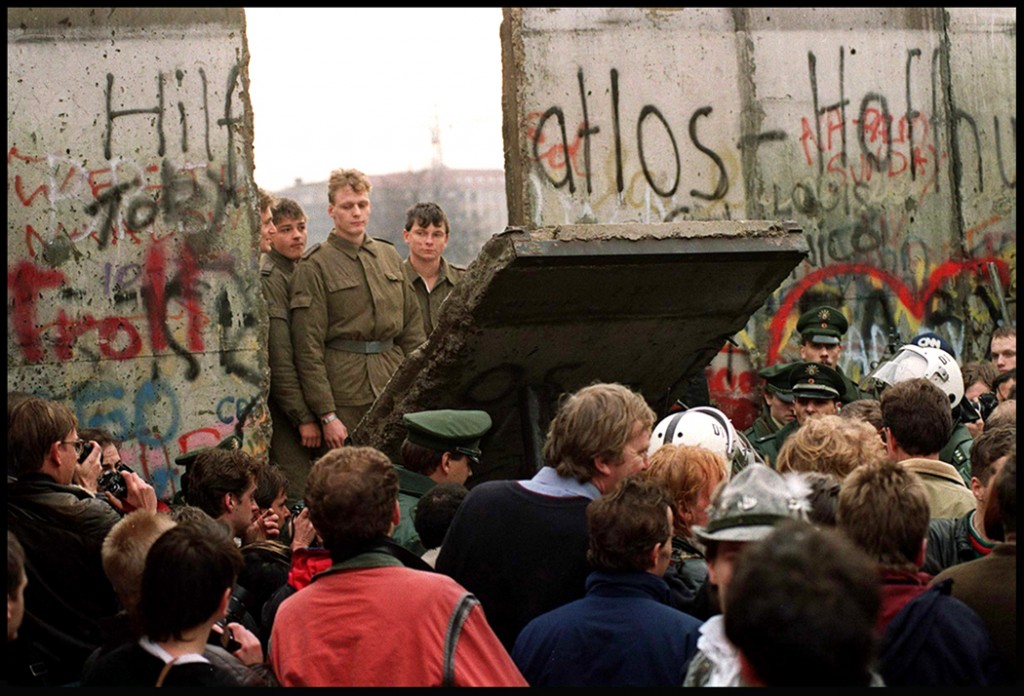 West Berliners crowd in front of the Berlin Wall early Nov. 11, 1989 as they watch East German border guards demolishing a section of the wall in order to open a new crossing point between East and West Berlin near Potsdamer Square. (AFP)
West Berliners crowd in front of the Berlin Wall early Nov. 11, 1989 as they watch East German border guards demolishing a section of the wall in order to open a new crossing point between East and West Berlin near Potsdamer Square. (AFP)
 Defecting East German soldier Hans Conrad Schumann leaps over a barbed wire barricade at the Bernauer Street sector into West Berlin on Aug. 15, 1961. Schumann made his break for freedom to join his family which had fled earlier to West Berlin. Schumann, who was immortalized in this photograph as he leapt across the barbed wire fence that became the Berlin Wall, hanged himself from a tree June 20, 1998 near his garden, police said. (Peter Leibing/Assocaited Press/Contipress)
Defecting East German soldier Hans Conrad Schumann leaps over a barbed wire barricade at the Bernauer Street sector into West Berlin on Aug. 15, 1961. Schumann made his break for freedom to join his family which had fled earlier to West Berlin. Schumann, who was immortalized in this photograph as he leapt across the barbed wire fence that became the Berlin Wall, hanged himself from a tree June 20, 1998 near his garden, police said. (Peter Leibing/Assocaited Press/Contipress)
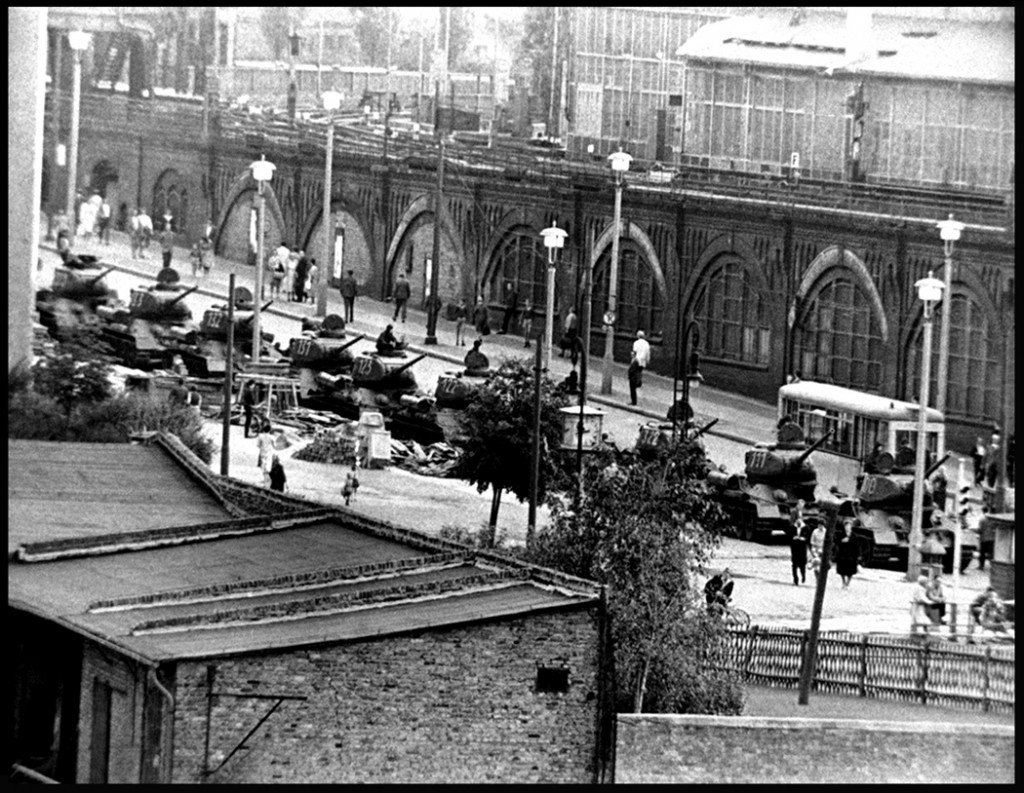 East German tanks lined up at Warschauer Bridge in Berlin, Germany Aug. 13, 1961. Crossing points between East and West Berlin were heavily guarded after Communists prevented East Germans from crossing into the West sector in an effort to stop heavy flow of refugees. (Peter Hillebrecht/Associated Press)
East German tanks lined up at Warschauer Bridge in Berlin, Germany Aug. 13, 1961. Crossing points between East and West Berlin were heavily guarded after Communists prevented East Germans from crossing into the West sector in an effort to stop heavy flow of refugees. (Peter Hillebrecht/Associated Press)
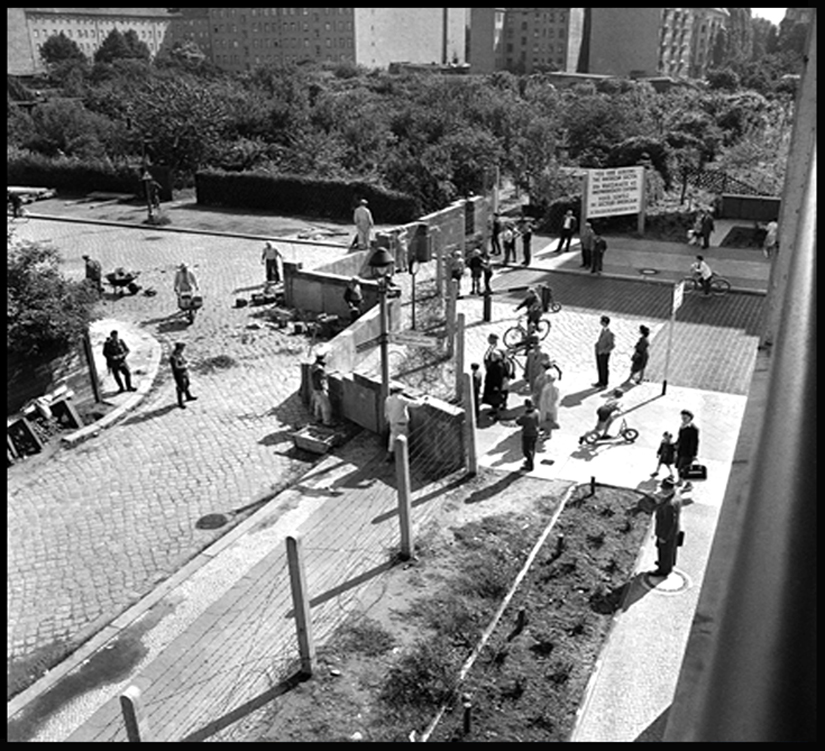 East German workers (left) assemble a wall of concrete blocks in the French sector of East Berlin Aug. 15, 1961. (Eddie Worth/Associated Press)
East German workers (left) assemble a wall of concrete blocks in the French sector of East Berlin Aug. 15, 1961. (Eddie Worth/Associated Press)
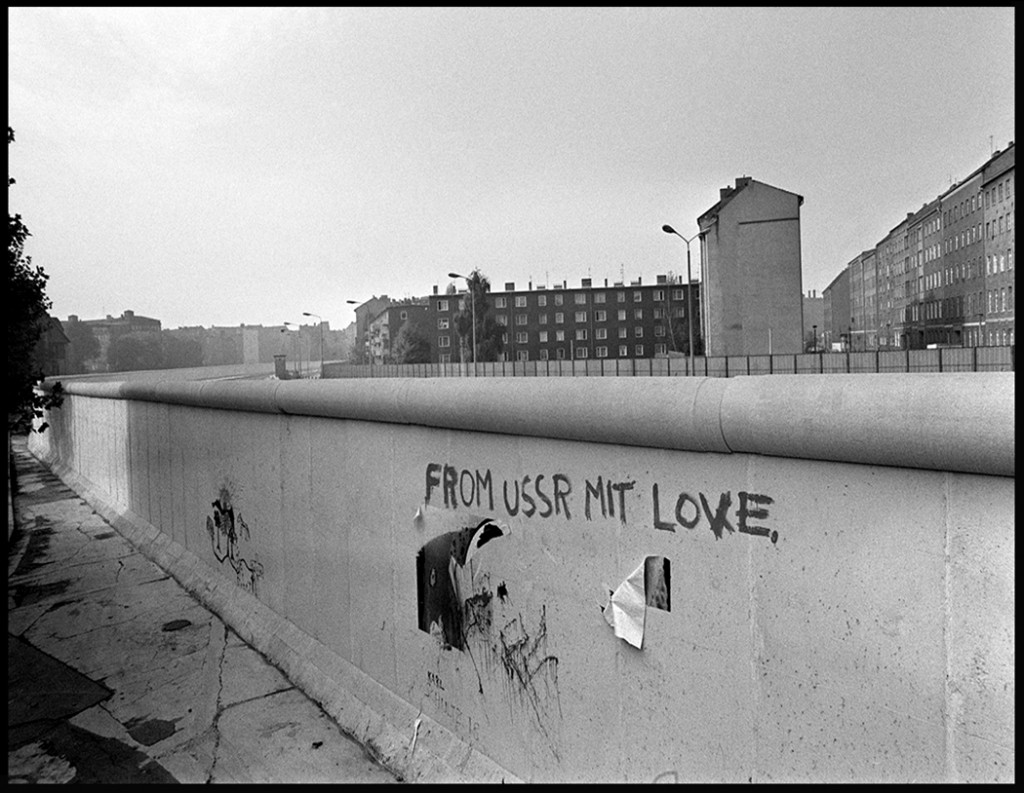 An inscription “from USSR mit love” on the Berlin Wall Oct. 13, 1976. The Berlin Wall might be history but the debate over its construction 50 years ago still weighs heavily on Germany’s collective consciousness as seen in an unseemly political row. With two regional elections set for September 2011, the Social Democratic Party (SPD) has lashed out at the left-wing Linke party, a sometime ally, for recently defending the building of the Wall. (Ralph Gatti/AFP/Getty Images)
An inscription “from USSR mit love” on the Berlin Wall Oct. 13, 1976. The Berlin Wall might be history but the debate over its construction 50 years ago still weighs heavily on Germany’s collective consciousness as seen in an unseemly political row. With two regional elections set for September 2011, the Social Democratic Party (SPD) has lashed out at the left-wing Linke party, a sometime ally, for recently defending the building of the Wall. (Ralph Gatti/AFP/Getty Images)
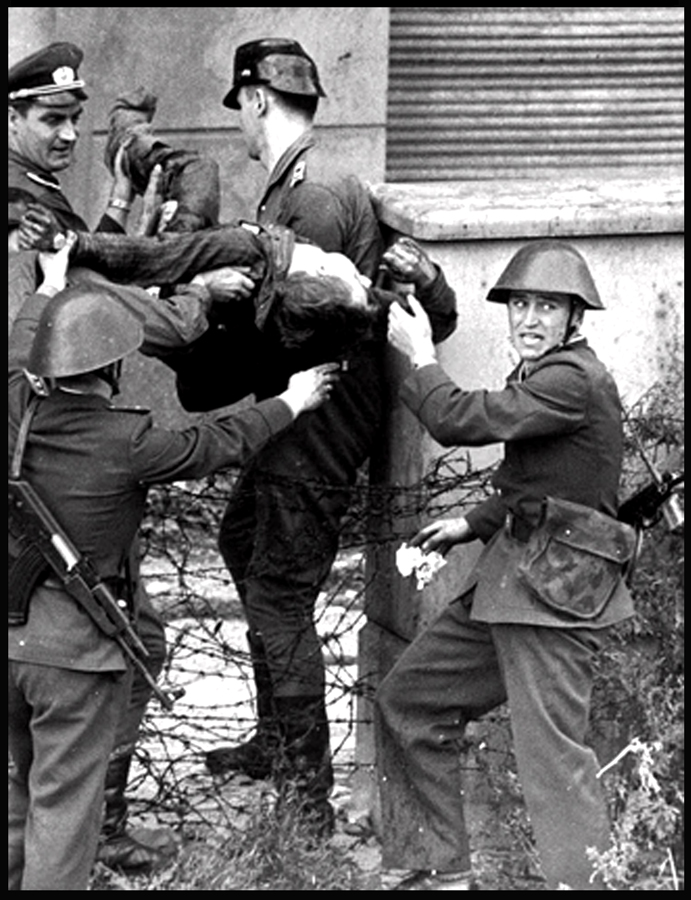 Peter Fechter is held by East German border guards, prior to being pronounced dead Aug. 17, 1962. Fechter was shot by East German guards as he tried to make it over the wall. (Associated Press)
Peter Fechter is held by East German border guards, prior to being pronounced dead Aug. 17, 1962. Fechter was shot by East German guards as he tried to make it over the wall. (Associated Press)
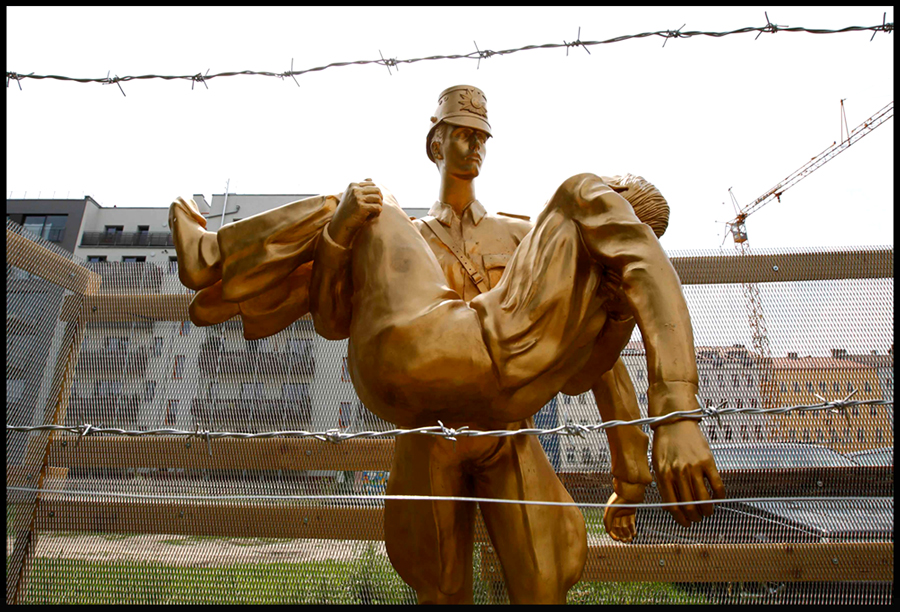 The sculpture ‘Mauerdenkmal 1000’ (‘Wall memorial 1000’) by artist Florian Brauer, on the so-called ‘death strip’, (no man’s land), at the former Berlin Wall site in Bernauer Strasse June 16, 2011. The sculpture, which is part of events the German capital is holding to mark the 50th anniversary of the building of the Berlin Wall, is based on the scene when East German citizen Peter Fechter was eventually carried away by a GDR border guard, an hour after he was shot by guards on Aug. 17, 1962 as he attempted to climb over the Wall to West Berlin. Severely wounded, Fechter fell back onto the border strip at the base of the Berlin Wall and lay there bleeding to death without medical assistance. West Berlin police were not permitted to intervene, nor did the border troops of the western Allies at Checkpoint Charlie get involved. He was not carried away by GDR border guards until almost an hour later. (Fabrizio Bensch/Reuters)
The sculpture ‘Mauerdenkmal 1000’ (‘Wall memorial 1000’) by artist Florian Brauer, on the so-called ‘death strip’, (no man’s land), at the former Berlin Wall site in Bernauer Strasse June 16, 2011. The sculpture, which is part of events the German capital is holding to mark the 50th anniversary of the building of the Berlin Wall, is based on the scene when East German citizen Peter Fechter was eventually carried away by a GDR border guard, an hour after he was shot by guards on Aug. 17, 1962 as he attempted to climb over the Wall to West Berlin. Severely wounded, Fechter fell back onto the border strip at the base of the Berlin Wall and lay there bleeding to death without medical assistance. West Berlin police were not permitted to intervene, nor did the border troops of the western Allies at Checkpoint Charlie get involved. He was not carried away by GDR border guards until almost an hour later. (Fabrizio Bensch/Reuters)
More links and information
Please visit the following links for more information:
Remembering the Berlin Wall
Berlin Wall – Times Topics
The Wall – Wikipedia entry
MSN & The NewYorkTimes
On a Memory-Filled Date, the Fall of the Berlin Wall Stands Front and Center
The New York Times
ALISON SMALE 5 hrs ago
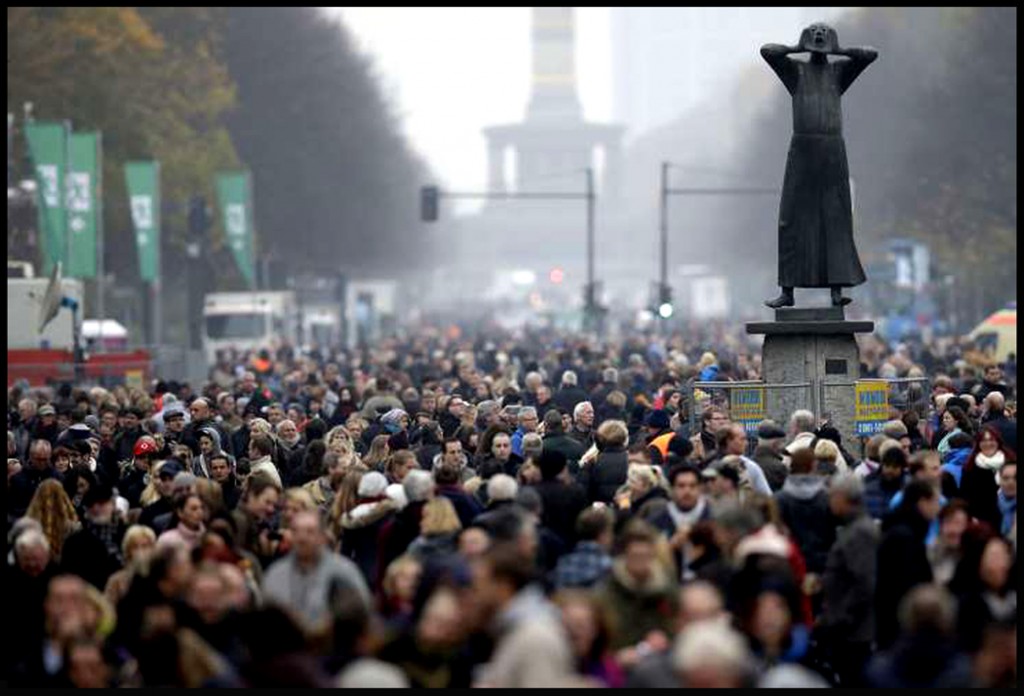 © Michael Sohn/Associated Press Visitors gathered in front of the Brandenburg Gate in Berlin on the 25th anniversary of the fall of the Berlin Wall.
© Michael Sohn/Associated Press Visitors gathered in front of the Brandenburg Gate in Berlin on the 25th anniversary of the fall of the Berlin Wall.
BERLIN — If memory needs places, Berlin was the place this weekend to remember the horror of the Berlin Wall, and the joy of unexpected liberation that accompanied its fall 25 years ago Sunday.
With her customary decorum, Chancellor Angela Merkel led her country in celebrations flavored with the only-in–Germany mix of triumph and tragedy.
In a 20-minute speech at a new memorial to the tragedies wrought by the wall, Ms. Merkel noted the special meaning of Nov. 9 in German history. It was on that day, in 1918, that Kaiser Wilhelm II abdicated, “after four terrible years” of World War I. In 1923, it was the date of Hitler’s failed march on the Munich Festhalle. In 1938, she said, it was when the Nazis set fire to synagogues, plundered Jewish homes and businesses and detained and killed thousands of Jews — “the start of the killing of millions” in the catastrophe of the Holocaust.
Only in 1989, after Europeans across the Soviet bloc were rising up against Communism, did Nov. 9 become a date of joy with the wall falling. Now, Ms. Merkel and many other speakers this weekend noted, it is up to Germans to nurture the memory, preserve democracy and intervene to prevent injustice.
Thousands of words were spoken as hundreds of thousands of visitors converged on Berlin and captured millions of moments in the digital universe that did not exist a quarter-century ago. Where words and images were insufficient, the genius of Bach and Beethoven was summoned to express feelings.
Dorothea Ebert, a violinist who spent time in an East German jail after an unsuccessful attempt to flee to the West in 1983, performed for the chancellor and about 100 guests at the opening of the memorial, playing Bach’s Allemande from the Partita in D minor for solo violin. Hours later, the conductor Daniel Barenboim was to lead the Staatskapelle Berlin and the Staatsoper choir in Beethoven’s “Ode to Joy” at the Brandenburg Gate.
The citywide celebrations drew a number of foreign dignitaries, including Lech Walesa, the founder of Poland’s Solidarity trade union; Miklos Nemeth, prime minister of Hungary when it opened the first hole in the Iron Curtain, allowing East Germans who were visiting Hungary to cross into Austria months before the wall fell; and the former Soviet leader Mikhail S. Gorbachev, whose glasnost and perestroika policies paved the way for the successful popular uprisings across the Soviet bloc in 1989.
But it was, above all, a German event.
Ms. Merkel focused on Bernauer Strasse, the site in north Berlin where the wall literally ran through houses and people jumped to freedom from their windows as the wall went up on Aug. 13, 1961. It is now the site of an open-air memorial and museum that Berlin’s mayor, Klaus Wowereit, said would attract more than a million visitors this year.
After laying a yellow-and-red rose in memory of the 138 people killed trying to cross the wall — hundreds more died at the border that divided Germany itself — Ms. Merkel attended a brief religious service at which Berlin’s Lutheran bishop, Markus Dröge, extolled the “great and fragile gift of freedom.”
Christian Klopf, a local Berliner who helped start the drive for a memorial at the site, said that he passed it every day on a once-impossible journey from East to West. “And every day it is a great feeling,” he said.
Renate Fischer, another local resident, recalled how activists like herself at first just wanted to reform East Germany. “But then the impossible happened, and today it is routine,” she said.
Many of the East Germans who led the small but vocal dissident movement were prominent in this weekend’s celebrations. On Friday, Wolf Biermann, a singer who was stripped of his East German citizenship by the Communists in 1976, caused a stir when he used an appearance in the German Parliament to attack the Left Party, which consists partly of former Communists. When reminded that he had no right to make a speech, Mr. Biermann retorted that he was not going to be silenced now.
Indeed, he gave another concert for Ms. Merkel and hundreds of others on Saturday night. Some activists — including Roland Jahn, now the commissioner in charge of the huge archives of the Stasi, East Germany’s much-feared secret police — went on to other parties, thanking West German journalists for their help 25 years ago, and generally reveling in the satisfaction of success.
At the memorial opening Sunday, one former activist, Markus Meckel, 62, recalled how he returned home late on Nov. 9, 1989, in Magdeburg, and was astonished to learn that the wall had fallen. “For weeks, we had already had the feeling that we were going to succeed with democracy,” Mr. Meckel said. Only after that, he added, would they deal with the wall. “It was clear that you could not do one without the other,” he said. So when the wall tumbled in just a few hours, “I was just thinking: Things will get more complicated.”
How much more complicated has become clear this anniversary with the events in nearby Ukraine, a topic that hung over a brief meeting Ms. Merkel had with a few dozen former East Germans who visit schools and share their experiences, lest young people forget what dictatorship and democracy have meant over the past decades here.
Volker Wetzk, 46, drew the ire of East German officials in the spring of 1989 for refusing to say that he would obey the shoot-to-kill order when doing his mandatory service guarding the border with the West.
© Carsten Koall/Getty Images Chancellor Angela Merkel of Germany and other dignitaries placed flowers between slats of the former Berlin Wall at a memorial Sunday.
On Sunday, he gently admonished Chancellor Merkel for not saying more about Ukraine in her speech. She discussed the need to stick to diplomacy — just as the Americans, British and French had not risked military force to try to undo the division of Berlin, she noted.
Barbara Grosser, 67, another former East German who was jailed for trying to leave her country and eventually moved West, spoke of a widely shared reluctance about using force in any circumstances.
“If someone talks about using force, I am frightened,” she said. “They are highly well equipped and have fewer scruples than we do,” she added, alluding to Russian forces. “So I would really be afraid.”
Please visit the following link for more information:
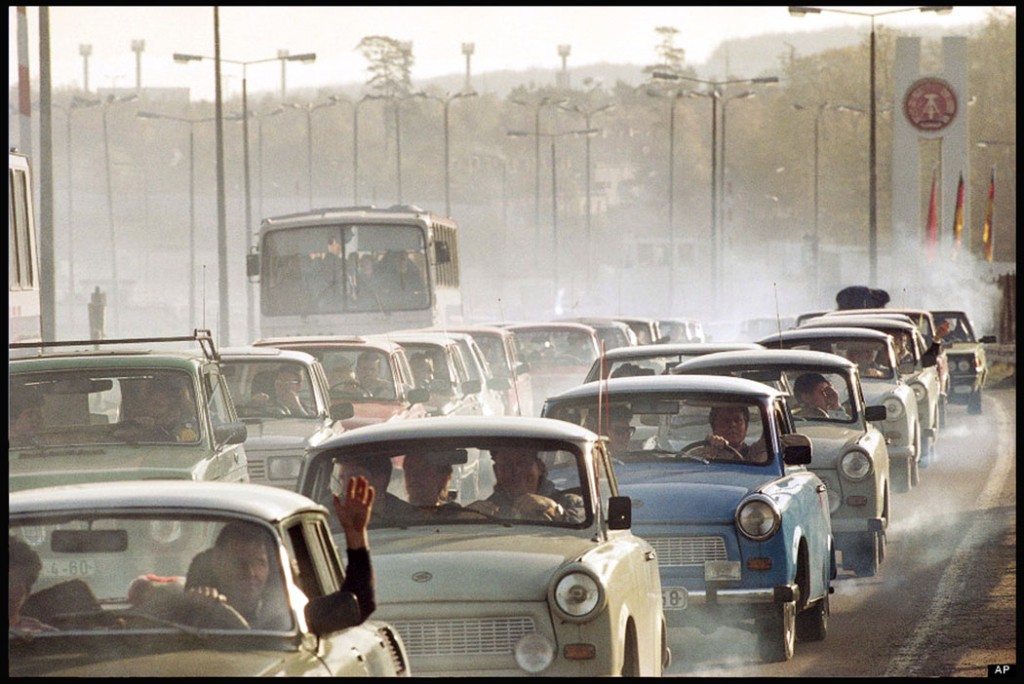
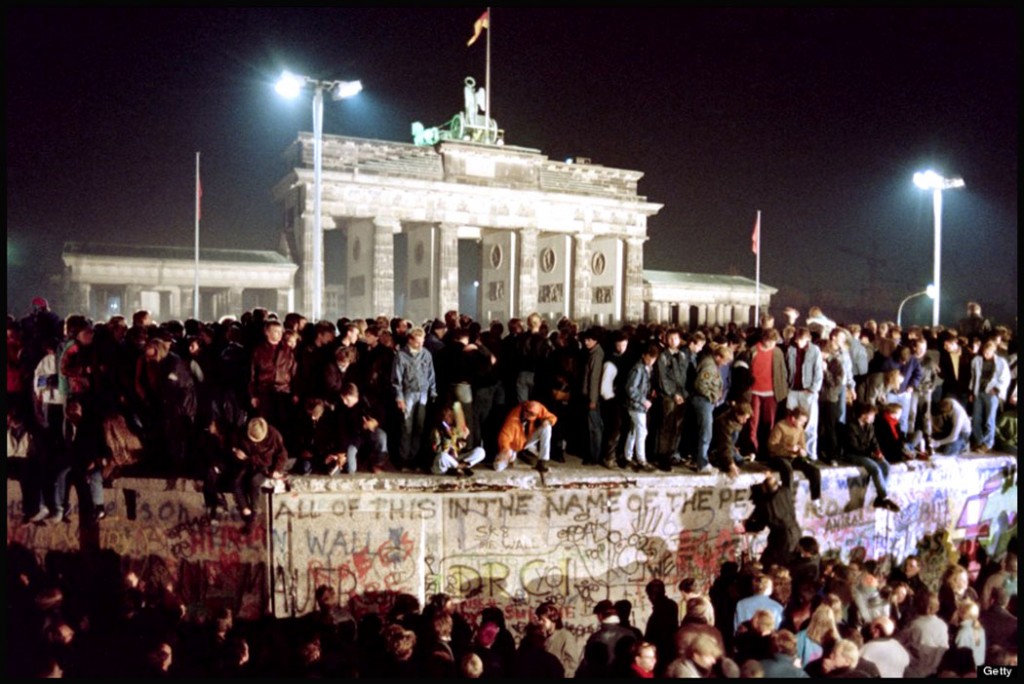
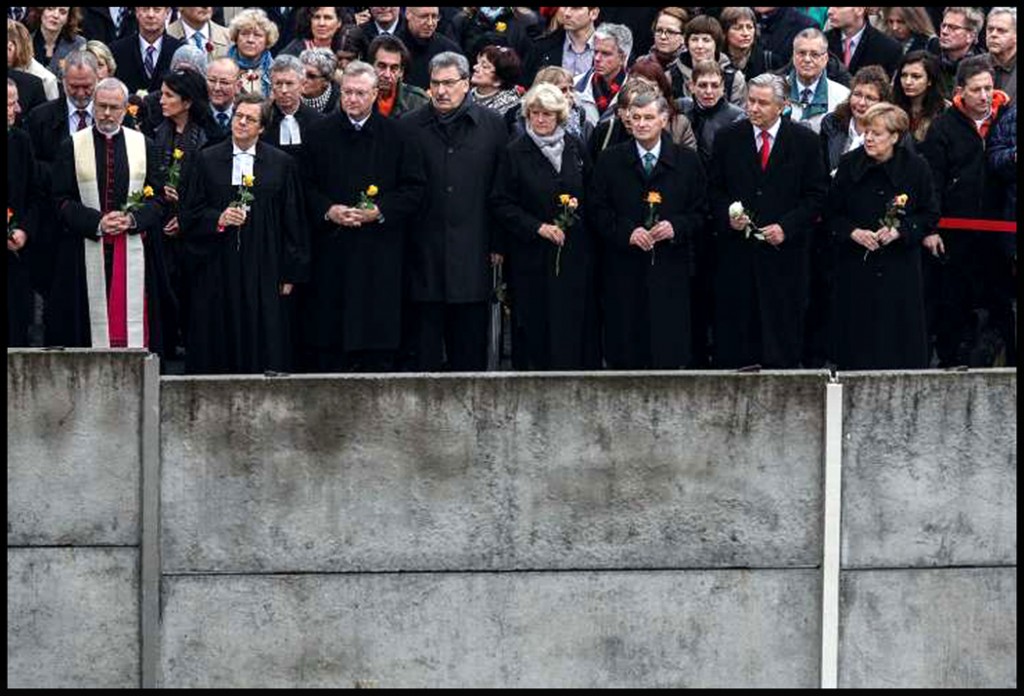
Leave a Reply